Phayao: The Ultimate Guide (2025)
Phayao (พะเยา) is a picturesque gem in Northern Thailand that offers a serene escape from busy city life. It’s both a province and the name of its small capital city, nestled in a mountain-ringed valley near the Laos border. The area centers around the tranquil Kwan Phayao lake, providing a stunning backdrop to the town’s laid-back lakeside lifestyle. Steeped in history, this region was an independent kingdom (Phukamyao) in the 11th century before joining the Lanna Kingdom in 1338. Phayao remained a quiet district of Chiang Rai until 1977, when it became its own province – a factor that helped preserve its unique Lanna heritage and small-town charm.
The ride to Phayao runs across open plains before reaching the calm lakeside town, where winds can be strong in the afternoon. Riders should refuel before the final stretch, as stations grow sparse along the way, and watch for slick surfaces after brief rain showers. Timing a late lunch avoids crowds at the lakeside restaurants. For steady and relaxed highway cruising, a motorbike rental from our fleet is the most suitable choice.
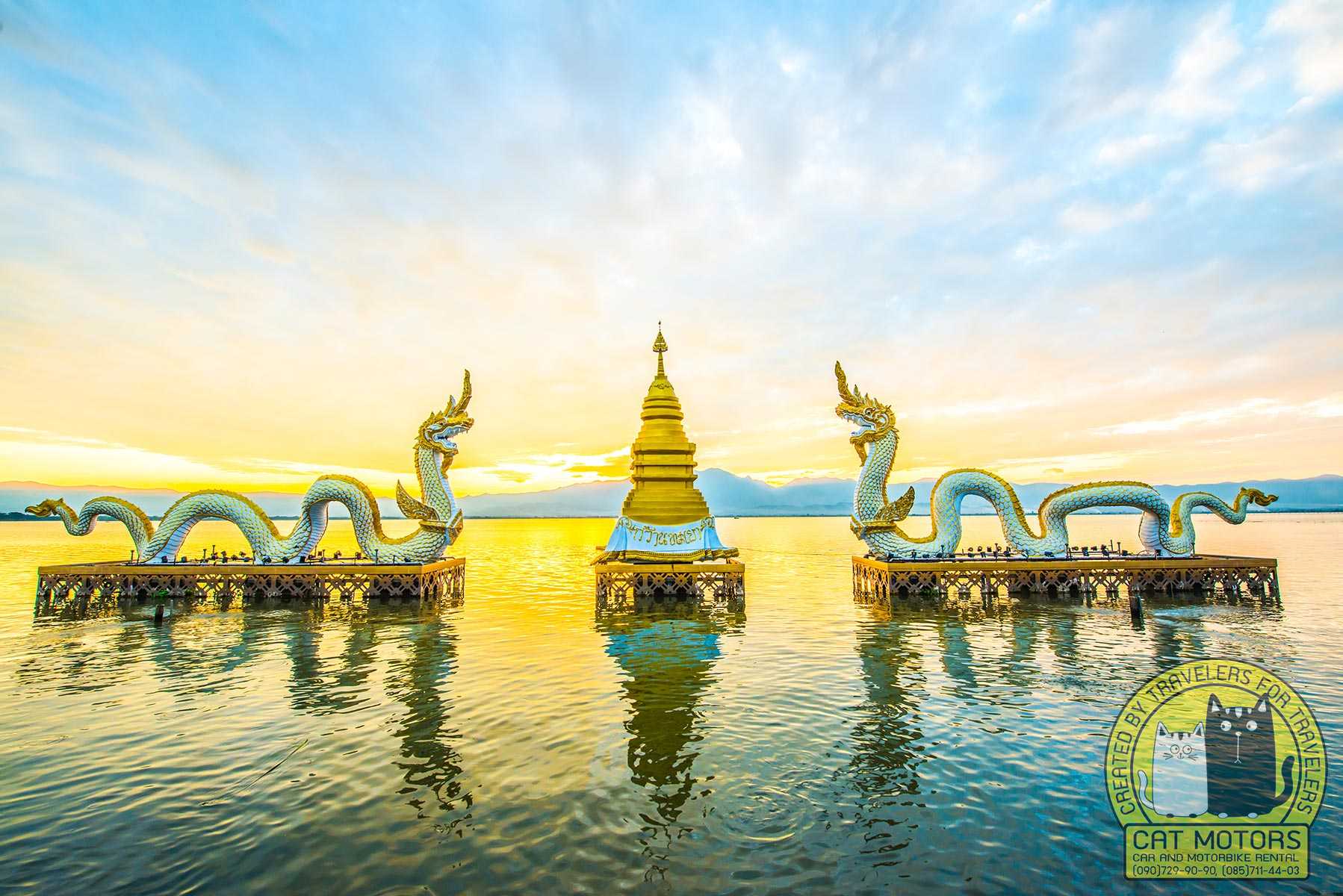
Phayao Lake at sunset, with its floating pagoda and legendary serpent sculptures, exemplifies the province’s tranquil beauty.
Today, the province is known for pristine nature, rich cultural traditions, and warm local hospitality. Surrounded by lush green mountains, it offers a mix of attractions—from ancient temples and quaint villages to national parks teeming with waterfalls and wildlife. Visitors can stroll or cycle along the scenic lakefront promenade, explore centuries-old temples adorned in elegant Lanna and Thai Lue architecture, and mingle with locals at bustling fresh markets while sampling Northern Thai cuisine. Despite its treasures, Phayao remains off the typical tourist trail, so you’ll encounter fewer crowds and a more authentic Thai experience. Friendly residents, a slow pace of life, and affordable prices make this an enchanting destination for travelers seeking nature, history, and local charm away from the usual hotspots. This travel guide covers the best places to visit in Phayao, along with practical tips to help you plan an unforgettable journey to this underrated northern province.
Quick Facts About Phayao
- Geography: Located in northern Thailand, Phayao province is bordered by Nan, Lampang, Chiang Rai, and Laos. The Phi Pan Nam mountain range runs north–south through the province, and the capital town sits on the shores of Kwan Phayao (Phayao Lake) in the Ing River valley.
- Capital: The provincial capital is Phayao Town (Phayao City), a small, relaxed lakeside town known for its scenic waterfront and laid-back atmosphere.
- Area: The province covers about 6,335 square kilometers of mostly mountainous terrain and fertile valleys.
- Population: Approximately 500,000 people live in Phayao province, with only ~18–19,000 in Phayao Town. The population is predominantly Northern Thai, along with several ethnic minority communities.
- Language: Thai is the official language, and a Northern Thai dialect (Lanna) is widely spoken. English is not common outside of tourist services, so learning a few basic Thai phrases is very helpful.
- Climate: Phayao has a tropical climate with three seasons: a rainy season (May–Oct), a cool season (Nov–Feb), and a hot season (Mar–Apr). The cool season brings pleasant temperatures, while the hot season can see daytime highs above 35°C.
- Key Attractions: Top sights include Kwan Phayao (Phayao Lake), Wat Si Khom Kham (home to one of the largest Lanna-style Buddha images), Wat Analayo temple, and natural sites like Phu Sang and Doi Phu Nang National Parks.
- Economy: Agriculture is a mainstay of the economy. The province produces rice, corn, lychee, and other fruits, and fishing is important around the lake. Tourism is growing gradually, focused on eco-tourism and cultural experiences.
- History: Phayao was an independent kingdom (the Kingdom of Phukamyao) established in the 11th century and ruled by its own kings until it was annexed by Lan Na in 1338. It later fell under Burmese and then Siamese (Thai) control along with the rest of Lanna. Phayao became a separate province only in 1977, which allowed it to develop at a slower pace and preserve much of its heritage.
- Culture: Local culture reflects Lanna roots and Thai Lue influences. You’ll find traditional crafts (weaving, woodcarving), vibrant festivals, and distinctly Northern Thai cuisine. Many locals still practice age-old customs, and the province is dotted with historic temples and monuments.
- Transportation: Phayao is accessible by road from major northern cities. Buses connect Phayao with Chiang Mai, Chiang Rai, and Bangkok. Within the province, local transport includes songthaews (shared pickup trucks), tuk-tuks, and buses, though having your own vehicle or a motorbike is ideal for exploring.
- Education: The University of Phayao, located just outside the city, is a major institution in the area and contributes to a youthful vibe in some parts of town.
- Healthcare: Phayao has a regional hospital and several clinics in town, plus smaller hospitals in outlying districts. They are adequate for routine and emergency care, but specialized treatment may require a trip to Chiang Rai or Chiang Mai.
- Cuisine: Northern Thai cuisine dominates, featuring herbs and spices unique to the region. Signature local dishes include Khao Soi (creamy curry noodle soup), Sai Ua (herbal Chiang Mai sausage), and Nam Prik Ong (spicy tomato-pork dip) eaten with sticky rice and vegetables. Freshwater fish from Phayao Lake is also popular in local recipes.
Festivals: Phayao celebrates festivals with enthusiasm. The Loy Krathong festival (ลอยกระทง) in November is especially beautiful on Phayao Lake, with candle-lit floats set adrift on the water. In April, Thai New Year Songkran brings lively water fights and traditional merit-making at temples. Other local events include Lanna cultural festivals and agricultural fairs.
Best Time to Visit Phayao
The cool season (November to February) is widely regarded as the best time to visit Phayao. During these months, the weather is comfortably cool and mostly dry – perfect for outdoor activities like hiking to mountain viewpoints or exploring town on foot. Daytime temperatures range from the low 20s °C up to around 30°C, with cooler nights (especially in the hills). This season also coincides with vibrant cultural events. For example, in November the Loy Krathong festival sees locals gathering at Kwan Phayao to float decorative baskets on the lake under the full moon – a magical sight. The cool season is also ideal for witnessing the region’s famous “sea of mist” phenomenon from high viewpoints: early mornings in December and January often greet you with mist blanketing the valleys and rising like clouds around the mountains.
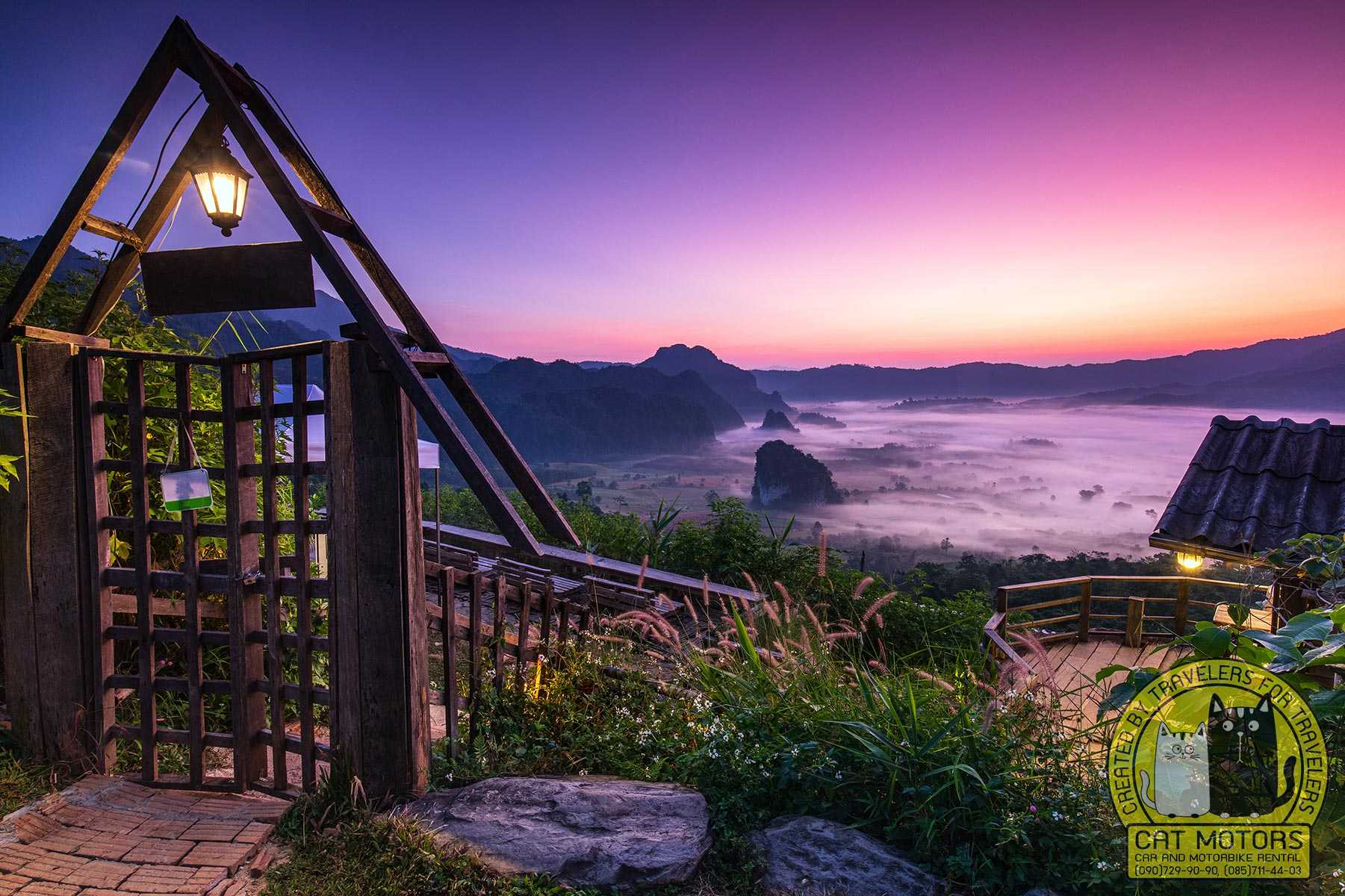
Cool season mornings in Phayao’s highlands (here at Magic Mountain Café in Phu Langka Forest Park) offer stunning “sea of mist” views over the valleys.
During the cool season, high-elevation spots like Magic Mountain Café (in Phu Langka Forest Park) offer stunning “sea of mist” views – a carpet of clouds filling the valley at dawn. This natural spectacle at sunrise is one of the rewards of visiting in the cooler months and draws many early risers and photographers.
By contrast, the hot season (March to April) brings high temperatures and often some haze. If you visit in April, you can experience the festive Songkran (Thai New Year) celebrations with friendly water-splashing everywhere, but be prepared for 35°C heat during the day. The rainy season (May to October) sees frequent rain showers but also lush green landscapes. Travel is still feasible since rains are usually intermittent, though some mountain roads can get muddy and hiking trails slippery. On the upside, the rainy months mean very green scenery, replenished waterfalls, and far fewer tourists. If you don’t mind occasional rain, visiting in late October or early November (at the tail end of monsoon) can be rewarding with fresh cool weather and lively Loy Krathong festivities. Overall, November through February offers the most pleasant weather and events, and is the peak period for Phayao tourism.
How to Get to Phayao
Phayao is somewhat off the main tourist track, but it’s accessible via several transportation options. The province has no active commercial airport, so most travelers arrive by road. Here are the common ways to reach Phayao:
- By Bus: Long-distance buses run to Phayao from Bangkok and Chiang Mai. From Bangkok, the journey is about 9–11 hours overnight (approximately 725 km). Buses depart Bangkok’s Mo Chit terminal and arrive at Phayao’s bus station in the town center. From Chiang Mai, several buses a day make the 3.5–4 hour trip, crossing scenic mountain routes into Phayao Province. Buses from Chiang Rai (around 2 hours away) and other nearby provinces are also available, making Phayao an easy stop on a northern Thailand itinerary.
- By Car: Driving to Phayao is straightforward on well-paved highways. From Bangkok, it’s roughly a 10–12 hour drive (via Highways 1 or 32, then 11). From Chiang Mai, drivers can take Route 118 then 120, a roughly 3-hour journey through the mountains. Having a car (or motorcycle) gives you flexibility to stop at viewpoints and explore rural areas along the way. Note that some mountain roads near Phayao’s attractions are winding, so drive cautiously.
- By Air: Phayao does not have a commercial airport. The nearest major airport is Chiang Rai International Airport (CEI), about 100 km northeast of Phayao. From Chiang Rai, you can reach Phayao by rental car or taxi (1.5–2 hours drive) or by bus from Chiang Rai city. Another option is flying into Chiang Mai Airport, then traveling by road ~3–4 hours to Phayao.
- By Train: There are no direct trains to Phayao. The closest you can get by rail is taking the northern line train from Bangkok to Lampang or Chiang Mai, then continuing by bus or car to Phayao. However, this is generally less convenient than direct buses. Most travelers coming from central Thailand will opt for the bus or a flight to a nearby city plus a road transfer.
Attractions and Things to Do in Phayao
Phayao may be a tranquil province, but it offers a surprisingly rich array of attractions. From shimmering lakeside panoramas to misty mountain peaks and historic temples, there’s plenty to see and do. Below are the best places to visit in Phayao and top experiences not to miss.
Kwan Phayao Lake
Kwan Phayao – the word “Kwan” means “lake” or “reservoir” in the local dialect – is the heart of Phayao Province. This large freshwater lake, the fourth largest in Thailand, is both a scenic wonder and the lifeblood of the region. The lake occupies a broad area at the edge of Phayao town and is encircled by a pedestrian-friendly promenade. Visiting Kwan Phayao offers not just natural beauty but also a window into local life and culture.

By day, you’ll see fishermen paddling out in small wooden boats, casting nets for the day’s catch – the lake is famed for its fish and has sustained nearby communities for generations. At sunrise and sunset, the views are breathtaking: the sky’s colors reflect off the calm water, often creating a mirror-like tableau of orange and pink hues. In the evening, the lakeshore comes alive as locals gather for leisurely walks and jogs, and food vendors set up stalls selling grilled fish, noodle soups, and snacks. Grab a seat by the water to enjoy a bowl of something delicious while the sun sinks behind the mountains.
One of Kwan Phayao’s intriguing secrets lies beneath its surface. Submerged in the lake are the remains of a 16th-century temple, Wat Tilok Aram, which was flooded when the lake was enlarged decades ago. During the dry season, when water levels drop, parts of this old temple – especially the tip of its pagoda – can sometimes be seen emerging from the lake, sparking local legends and curiosity. There is also a modern floating pavilion with a Buddha image on the lake, accessible by boat. On certain occasions (important Buddhist holy days), locals boat out to this floating shrine to make merit.
Nature enthusiasts will appreciate that Kwan Phayao is a haven for bird-watchers. The wetland ecosystem supports numerous bird species – you might spot egrets stalking the shallows or large flocks of migratory birds in the cooler months. The lake truly is the central heart of the region: in fact, the name Phayao reflects this (“Kwan” implies a central meeting point), and the lake is fed by 18 streams from the surrounding Phi Pan Nam Mountains. Don’t miss the chance to rent a bicycle and ride along the lakeshore in the morning, or hire a long-tail boat for a short lake tour. Whether you’re watching dawn break over misty waters or enjoying twilight reflections, a visit to Kwan Phayao is an essential, soul-soothing experience in this region.
Wat Tilok Aram
Located on a small island in Kwan Phayao Lake, Wat Tilok Aram is one of the area’s most fascinating historical sites – in part because it lies underwater. This 500-year-old Buddhist temple dates back to the 15th century, during the reign of King Tilokkarat of the Lanna Kingdom. Originally, Wat Tilok Aram stood on solid ground, but it was deliberately submerged in the mid-20th century when a dam project expanded the lake for irrigation. Today, the temple’s ruins rest about 3 meters beneath the lake’s surface, hidden from view for most of the year.
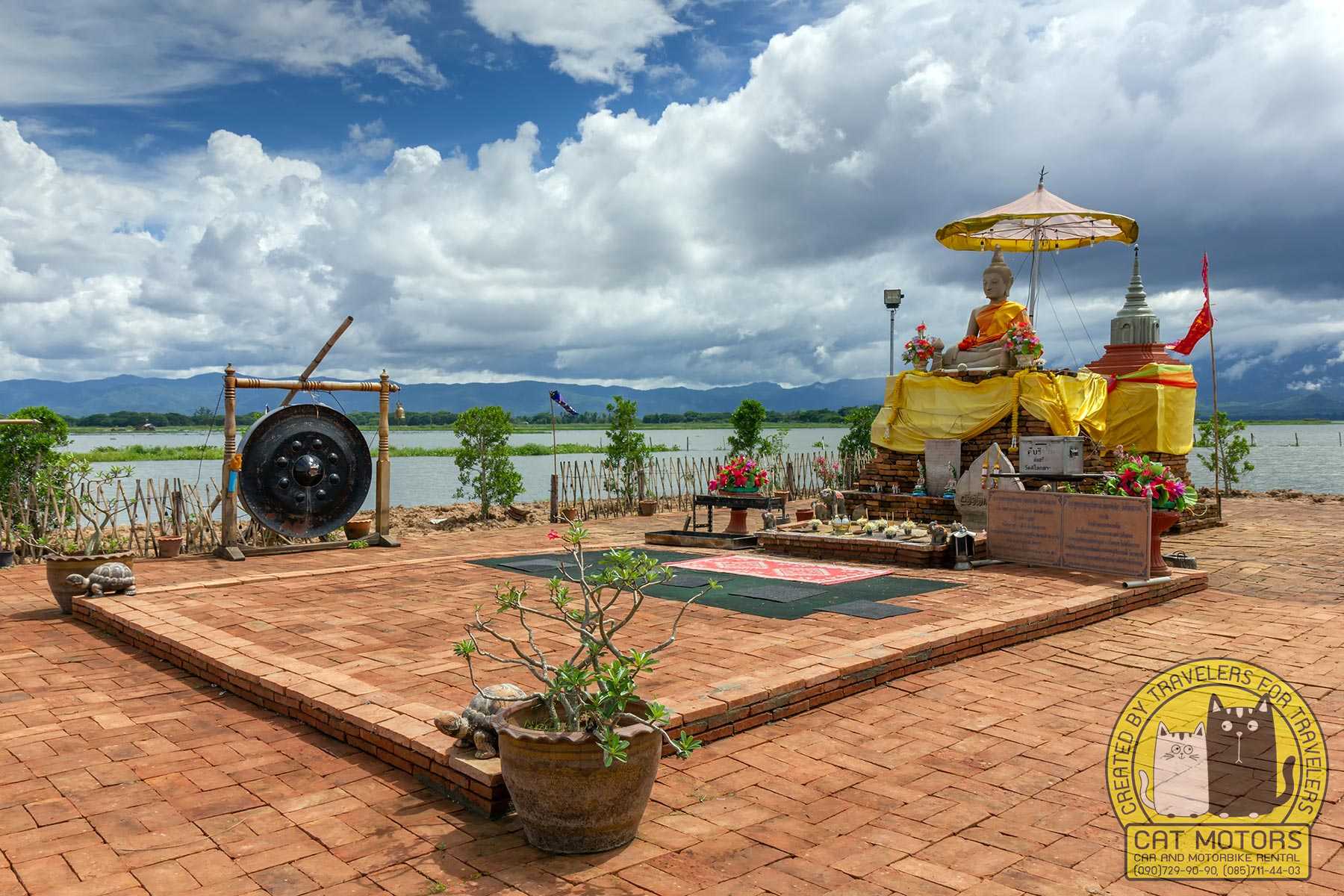
What makes Wat Tilok Aram special is that it hasn’t been forgotten. Locals know it’s there, and in the dry season (typically February to April) when lake levels recede, you can occasionally see bits of the old brick foundations or stupa poking above the waterline. A Buddha image from the temple was salvaged and placed in a shrine on a floating platform at the site. Visitors can hire a boat from the lakeshore (near the Wat Tilok Aram pier) to visit this floating shrine and the vicinity of the sunken temple. The boat ride is tranquil and offers panoramic views of the town and mountains. Upon reaching the shrine, you’ll often see locals paying respects – they might toss flower garlands into the water or float krathong offerings, honoring the once-important temple now hidden underwater.
Visiting Wat Tilok Aram is a unique experience blending history and legend. You are literally boating over a lost piece of Phayao’s past. The atmosphere in early morning can be mystical with fog on the lake, while late afternoon visits offer clear views into the water on sunny days. There has even been talk of raising or restoring parts of the temple someday, but for now it remains an underwater time capsule. A trip here is often combined with other lakeside attractions like Wat Si Khom Kham onshore. It’s a short excursion (about 15 minutes by boat from shore) but leaves a lasting impression, reminding travelers of the impermanence of landscapes and the layers of history beneath Phayao’s calm waters.
Wat Phra That Chom Thong
Perched on a small hill in Phayao City, Wat Phra That Chom Thong is a venerable temple that offers both spiritual insight and lovely views. This temple is said to predate the founding of Phayao itself, with local lore suggesting it’s over 1,200 years old (though the current structures are later Lanna style). The name Chom Thong means “to view gold,” referencing the gold-covered chedi (stupa) that is the centerpiece of the temple. In fact, the gilded chedi of Wat Phra That Chom Thong is believed to enshrine a sacred relic of the Buddha, making it a revered pilgrimage site for Thai Buddhists.
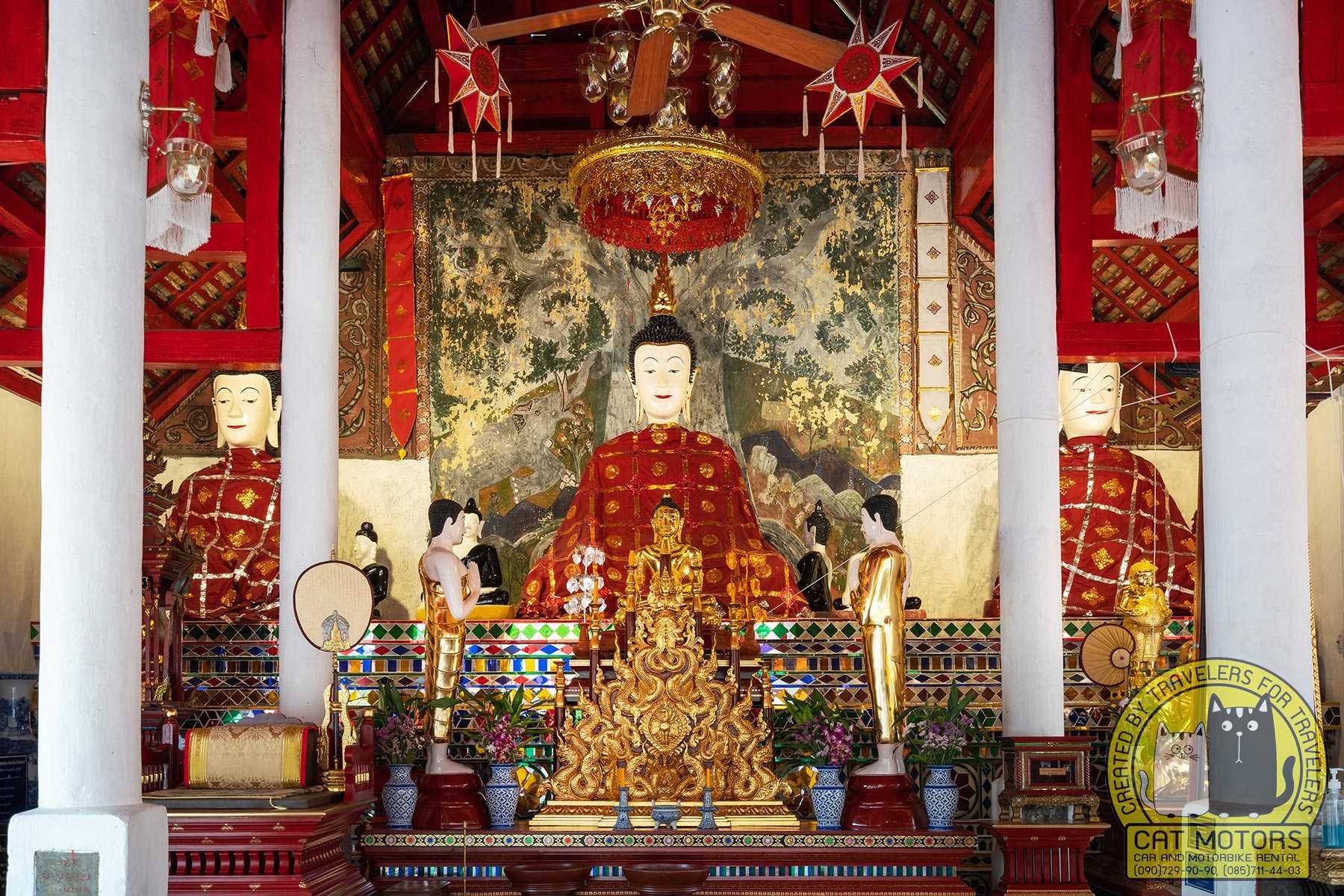
As you approach the temple, you’ll climb an ornate Naga (serpent) staircase flanked by greenery. The atmosphere is peaceful, with far fewer tourists than at the more famous temples in Chiang Mai. At the summit, the bell-shaped Lanna stupa gleams in the sun. Around it, the wihaan (prayer hall) and other buildings showcase northern Thai architecture: intricately carved wooden gables, steep multi-tiered roofs, and colorful murals depicting Buddhist stories. Inside the prayer hall, locals come to light candles and incense, especially on holy days, giving visitors a chance to quietly observe or even partake in Thai Buddhist customs.
One of the rewards of visiting Wat Phra That Chom Thong is the panorama. Since the temple sits on a hill (really more of a gentle rise), you get a charming view of Phayao town and the lake beyond the trees. It’s a great spot for photos, particularly in the soft light of morning or late afternoon. Informational plaques (in Thai and some English) around the temple describe its history and architecture, adding context to your visit. Monks from the temple are often present and may chat with respectful visitors – some are eager to practice their English. Wat Phra That Chom Thong may not be as grand as, say, Doi Suthep in Chiang Mai, but it has an authenticity and tranquility that are very appealing. It encapsulates Phayao’s blend of sacred heritage and natural beauty, making it a worthwhile stop on any tour of the town’s attractions.
Wat Huai Pha Kiang
Tucked in a forested area about 10 km north of Phayao Lake, Wat Huai Pha Kiang is a hidden gem for those interested in art, nature, and solitude. This serene temple is best known for the rock sculptures that lie somewhat concealed around its grounds. In contrast to the ornate buildings of most temples, Wat Huai Pha Kiang’s standout features are these rock-carved Buddhist images and figures, created by local artisans and monks to blend harmoniously into the natural environment. Because the carvings are not immediately obvious, exploring here feels like a treasure hunt – you wander the quiet wooded complex and suddenly discover a Buddha relief etched into stone or a carving in the cliff under the temple.
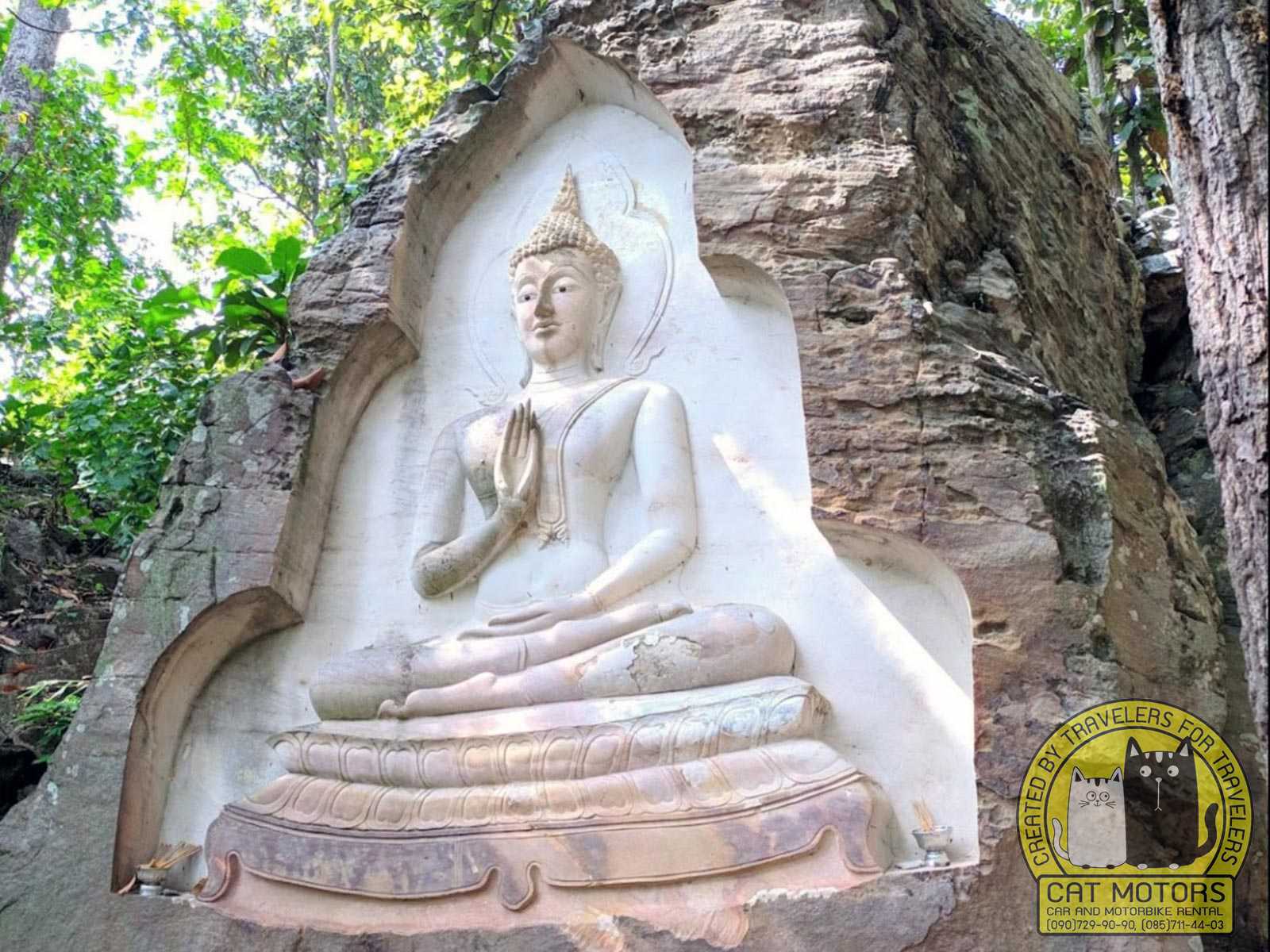
The temple compound itself is peaceful and shaded by trees. Near the parking area, there’s a pavilion housing a large reclining Buddha statue and even a Buddha’s footprint impression – signs that this is an active place of worship. Following the footpaths down toward a small stream, you begin to find the rock art: Buddha images, mythological creatures, and symbols from local folklore carved subtly into boulders and cliff faces. They are not brightly painted; instead they’re subtle and require a keen eye, which makes each discovery feel more intimate and special.
What’s particularly lovely about Wat Huai Pha Kiang is how undisturbed it is. It’s well off the beaten tourist path – even many Thai travelers aren’t aware of it – so you may find yourself completely alone here aside from an occasional monk or caretaker. The quiet, broken only by birdsong or rustling leaves, makes it an ideal spot for contemplation or meditation. It’s said that the temple remains so unknown that visitors often have the place entirely to themselves.
If you visit, consider bringing water and good walking shoes, as the terrain around the rocks can be uneven. There are no entrance fees; just behave respectfully as you would at any temple. Wat Huai Pha Kiang offers a unique mix of art, spirituality, and nature – it feels like an outdoor gallery set in a forest sanctuary. It’s a must-visit for temple enthusiasts or anyone looking to experience the quieter side of the region’s cultural heritage.
Pho Khun Ngam Muang Monument
In the center of Phayao town, not far from the lake, stands the Pho Khun Ngam Mueang Monument, a site of great local pride. Pho Khun Ngam Mueang was the 9th king of Phayao (historically known as Phu Kamyao) and is revered for his wisdom, benevolence, and the prosperity he brought to his kingdom in the 13th century. He is also famous for his alliance and friendship with two other legendary kings of that era: King Mengrai of Lan Na and King Ramkhamhaeng of Sukhothai. Together, these three formed a pact of friendship often cited as an early example of regional diplomacy in Thai history.
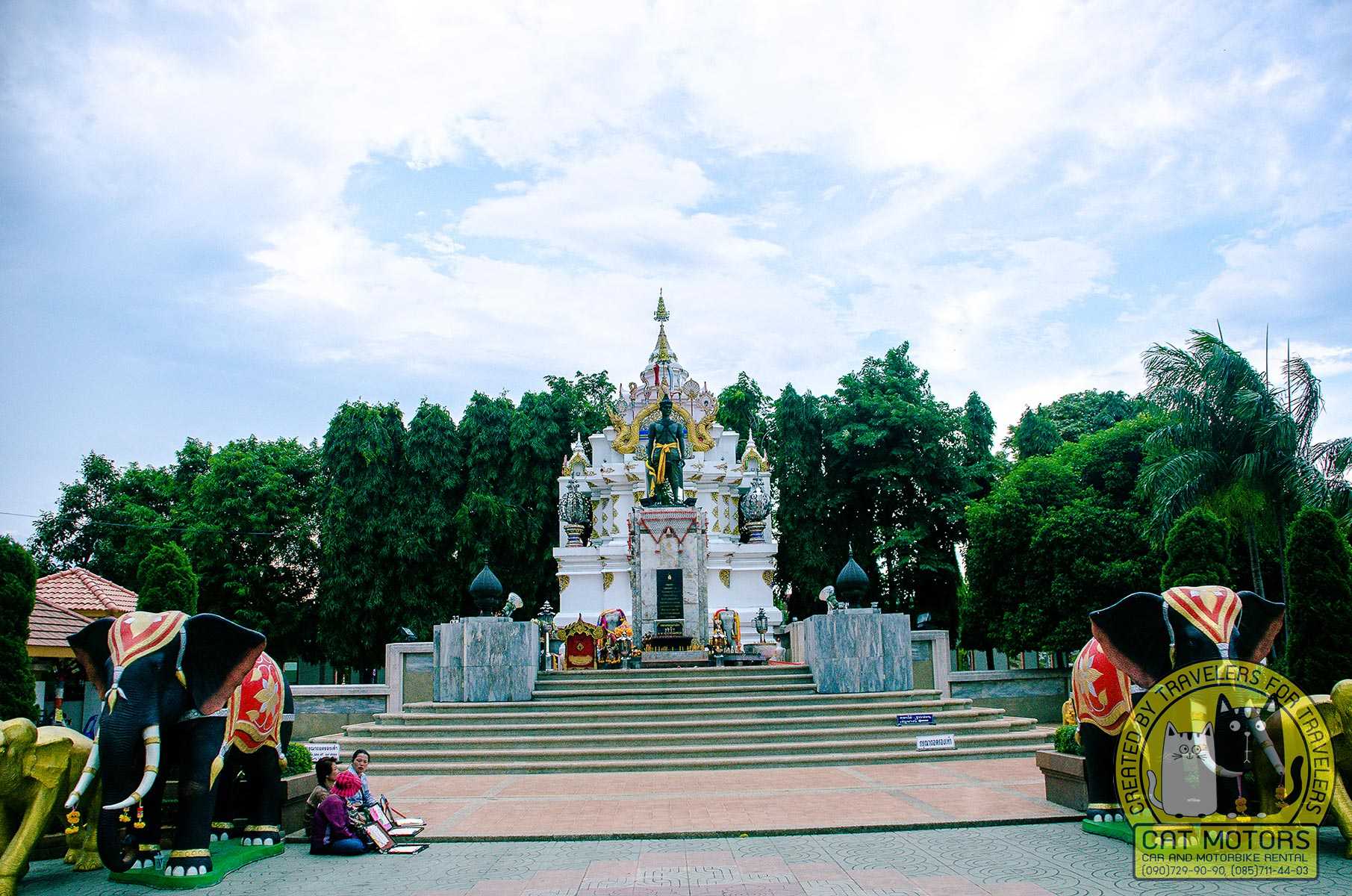
The monument itself is a striking bronze statue of King Ngam Mueang in royal regalia, positioned atop a high pedestal. Locals and visitors alike come here to pay homage. You’ll often see offerings of marigold garlands, incense, and candles at the foot of the statue. The site is especially busy on weekends and on the king’s birth anniversary, when ceremonies are held. It’s not uncommon to witness people praying or even local dance troupes performing traditional dances in his honor during certain celebrations.
Visiting the monument doesn’t take long – it’s essentially a quick stop – but it provides insight into the province’s history. The fact that this small province still remembers its ancient king shows the pride locals have in their heritage. An inscription (in Thai and English) near the statue recounts King Ngam Mueang’s deeds, including how he brought prosperity and stability to Phayao. For travelers, stopping by the monument is a nice way to break up a walking tour of town. It’s set in a small park where you can sit in the shade, and from the monument you’re a short walk to the lake or the main market area.
In sum, the Pho Khun Ngam Mueang Monument is a cultural touchstone. It honors a king little known outside the region, but whose legacy is deeply ingrained in local lore. Spending a few moments here to learn about him and observe how locals venerate their past will add depth to your understanding of Phayao’s identity.
Phu Langka Forest Park
Phu Langka Forest Park (วนอุทยานภูลังกา) is a nature lover’s paradise located in the far southeast of Phayao Province, bordering Nan Province. Renowned for its breathtaking landscapes, this protected area offers cool mountain air, lush forests, and panoramic viewpoints that have become iconic among in-the-know travelers. Phu Langka’s terrain is a mix of rugged limestone mountains, misty valleys, and fertile forests – a fantastic destination for hiking, photography, and experiencing rural Thai highland life.
One of the absolute highlights of Phu Langka is the early-morning “sea of mist.” At viewpoints such as Magic Mountain (called Tamoryod locally), you can watch the sun rise over a vast expanse of clouds filling the valley below, with dark mountain peaks poking up like islands in a white sea. This phenomenon is especially common in the cool season (roughly October through February). The Magic Mountain viewpoint – conveniently right next to a small coffee shop aptly named Magic Mountain Café – has gained fame on social media for its otherworldly sunrise scenes. Many travelers drive up in the pre-dawn darkness just to witness this, sipping a hot drink as the fog glows in the morning light.
During the day, Phu Langka offers several hiking trails through its rich forests. Trails range from short walks to more challenging treks up the peaks. Along the paths, you may encounter diverse flora (wild orchids, ferns, dense bamboo groves) and fauna – it’s a good area for birdwatching, and if you’re lucky you might spot dusky leaf monkeys or other wildlife. There are a couple of waterfalls and caves within the park as well, though the high viewpoints remain the main draw. One popular hike leads to Phu Nom peak, which provides a 360° view of the region.
Facilities in Phu Langka are basic but sufficient: there’s a small visitor center, some parking, and a few simple bungalows and campsites for those who want to stay overnight. (If you plan to camp or stay, it’s best to reserve through the park or local tour agencies in advance.) The altitude means it gets quite cool at night – even dropping below 10°C in December/January – so pack accordingly. Also, the roads to Phu Langka are steep and winding; if you’re not comfortable driving mountain roads, consider hiring a local driver or taking a songthaew from Phayao town or Chiang Kham.
Visiting Phu Langka is like stepping into nature’s tranquility. It’s the kind of place where clouds literally roll at your feet, and where small villages and farms in the valleys give a glimpse of traditional life (the area is home to Hmong and Thai Lue communities). Whether you’re standing atop Phu Langka at dawn or hiking under the forest canopy in the afternoon, this park showcases the untouched natural beauty of Phayao. It’s a must-visit for anyone who appreciates majestic landscapes and the calm of the mountains.
Magic Mountain Café
Nestled high in the hills within Phu Langka Forest Park, Magic Mountain Café has become one of the region’s most talked-about spots in recent years – and for good reason. This quaint open-air café offers coffee with a view that is second to none. Imagine sitting on a wooden deck with a warm cup in hand, gazing out over rolling green mountains and a valley blanketed in morning mist – Magic Mountain Café provides exactly that dreamlike experience.

The café itself is simple and charming, built with bamboo and wood that blend into the natural surroundings. It started as a local family’s small venture to cater to travelers coming for Phu Langka’s sunrise. They serve basic breakfasts, Thai coffee (from locally grown beans), tea, and a few snacks. Don’t expect a lavish menu – the real treat here is the ambiance. Most people arrive very early (around 5–6 AM) to grab a good spot on the deck before sunrise. It can get surprisingly busy at dawn as photographers and travelers gather for that perfect shot. On a cool, misty morning, the place truly feels magical: clouds float just below the deck, and as the sun rises, the mist slowly dissipates to reveal a lush valley and karst peaks in the distance.
Aside from the famous sunrise, Magic Mountain Café is delightful at other times of day as well. Later in the morning, once the dawn crowds have left, you might have the place nearly to yourself – a peaceful spot to relax and enjoy the mountain breeze. The staff (often the owners themselves) are friendly locals from a nearby village. They may not speak much English, but a smile and shared appreciation of the view bridge any language gap.
Keep in mind the café’s hours can be seasonal (generally open in the early morning until around 10 AM, and sometimes again in late afternoon for sunset). The road up is steep; many people visit as part of a guided pre-dawn trip from Phayao town or Chiang Kham. If you drive on your own, use caution in the dark. There’s a small parking area, and a short trail leads to the café’s perch.
Magic Mountain Café truly embodies the idea of a “destination café” – it’s absolutely about the destination. It’s the kind of experience you remember long after your trip: the taste of hot coffee mixed with crisp mountain air, the sight of the sun appearing over a sea of clouds, and the sense of wonder at Thailand’s natural beauty. Whether or not you’re an avid Instagrammer, you’ll likely snap a few photos here, if only to capture the feeling of being on top of the world in northern Thailand.
Phu Sang National Park
Located on Phayao’s northeast border (touching Laos), Phu Sang National Park is a verdant sanctuary known for its unique hot-spring waterfall and lush jungle scenery. Covering about 280 km², Phu Sang is part of the rugged Phi Pan Nam Range. The park’s elevations and forests are home to diverse flora like golden teak and Burmese padauk trees, and fauna including some rare species.
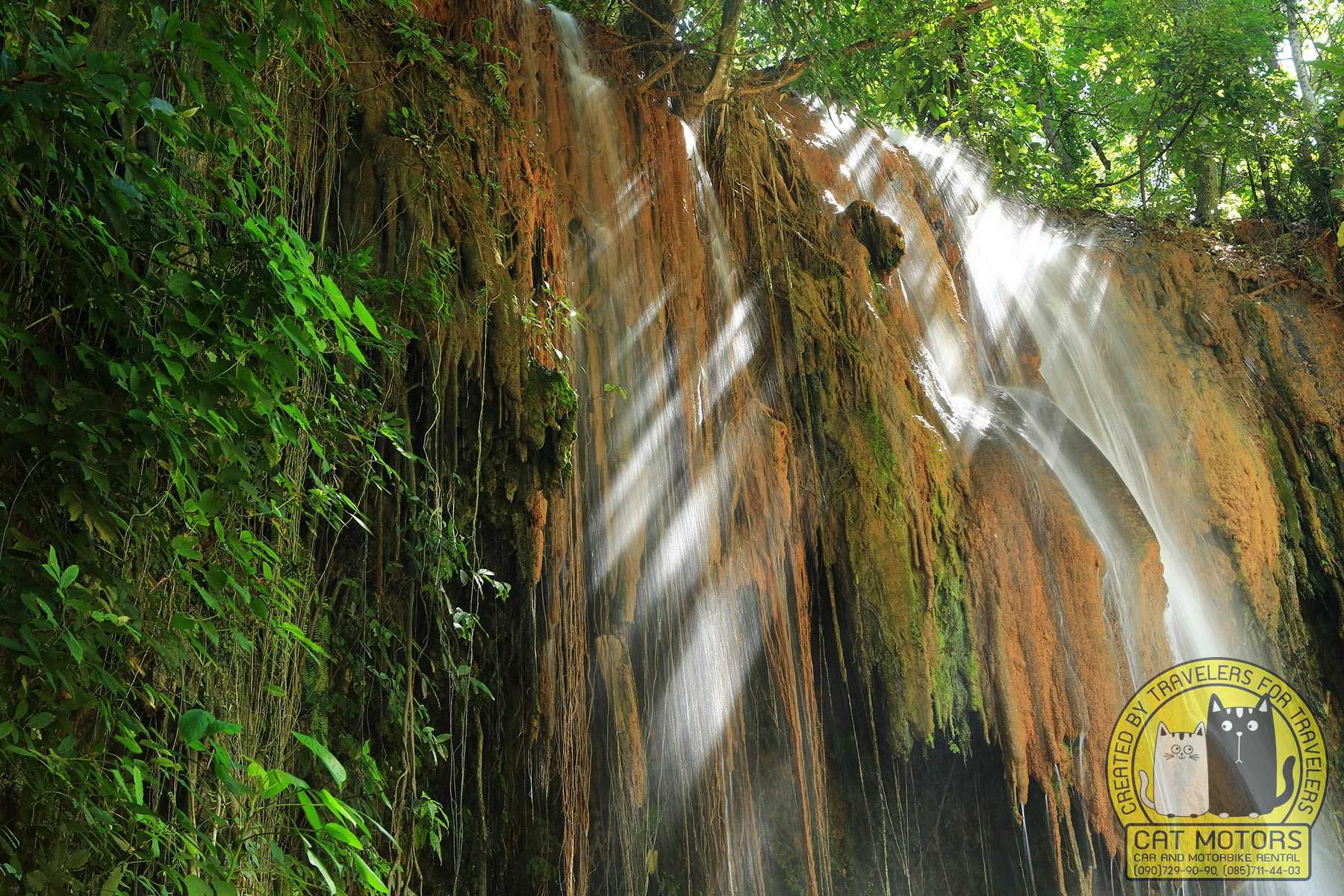
The waterfall, Namtok Phu Sang, is about 25 meters high and is fed by a thermal spring. Unusually, the water is a steady ~35°C year-round, forming a naturally warm pool at its base. (Bathing directly under the falls isn’t allowed, to preserve the site, but you can dip your feet in the warm stream just downstream.) The warmth also attracts wildlife; notably, at night you might spot the Siamese big-headed turtle, an endangered turtle species with a distinctively large head and long tail, which lives in the park’s waters. These turtles are often seen near the waterfall area after dusk – a testament to Phu Sang’s healthy ecosystem.
Visitors to Phu Sang can enjoy well-marked nature trails that wind through the forest along streams. These paths offer chances to see birds, butterflies, and perhaps monkeys in the trees. In addition to the main waterfall, there are also hot springs in the park (the source of the falls’ warm water) and several smaller cascades and rapids in the forest. One pleasant spot is the Phu Sang Warm Springs picnic area, where shallow warm streams flow – locals sometimes soak their feet here as a natural “spa.”
Facilities at Phu Sang are visitor-friendly: there’s parking, a visitor center with information displays, restrooms, and a few picnic tables. Near the waterfall, vendors often sell grilled chicken, sticky rice, and refreshments – a nice way to have lunch with a view. There’s also a campground and a few basic bungalows for those who wish to stay overnight (the park is very serene at night). The best time to visit is during or just after the rainy season (November to January) when the waterfall is flowing nicely and the weather is cooler. Even in hot season, Phu Sang’s forest provides shade and the waterfall flows year-round thanks to the spring.
Phu Sang National Park is a bit off the main tourist route but easily accessed by road (about 20 km from Phayao’s Chiang Kham district, or ~90 km from Phayao town). It offers a refreshing nature escape, and the combination of a waterfall you can wade in year-round and the possibility of spotting a rare turtle makes it quite special. If you’re doing a loop through Phayao and into neighboring Chiang Rai or Nan, Phu Sang is a great stop to experience Northern Thailand’s natural beauty – perhaps even enjoying a warm waterfall “shower” in the wilderness.
Doi Phu Nang National Park
Doi Phu Nang National Park is another natural jewel of Phayao, encompassing a large area of forested mountains and rich biodiversity in the southwest of the province. Covering over 537 km², this park is known for its scenic waterfalls, caves, and even wild peacocks. Doi Phu Nang is less visited than some other parks, giving it an untouched feel that’s perfect for adventurous travelers and those seeking quiet in nature.
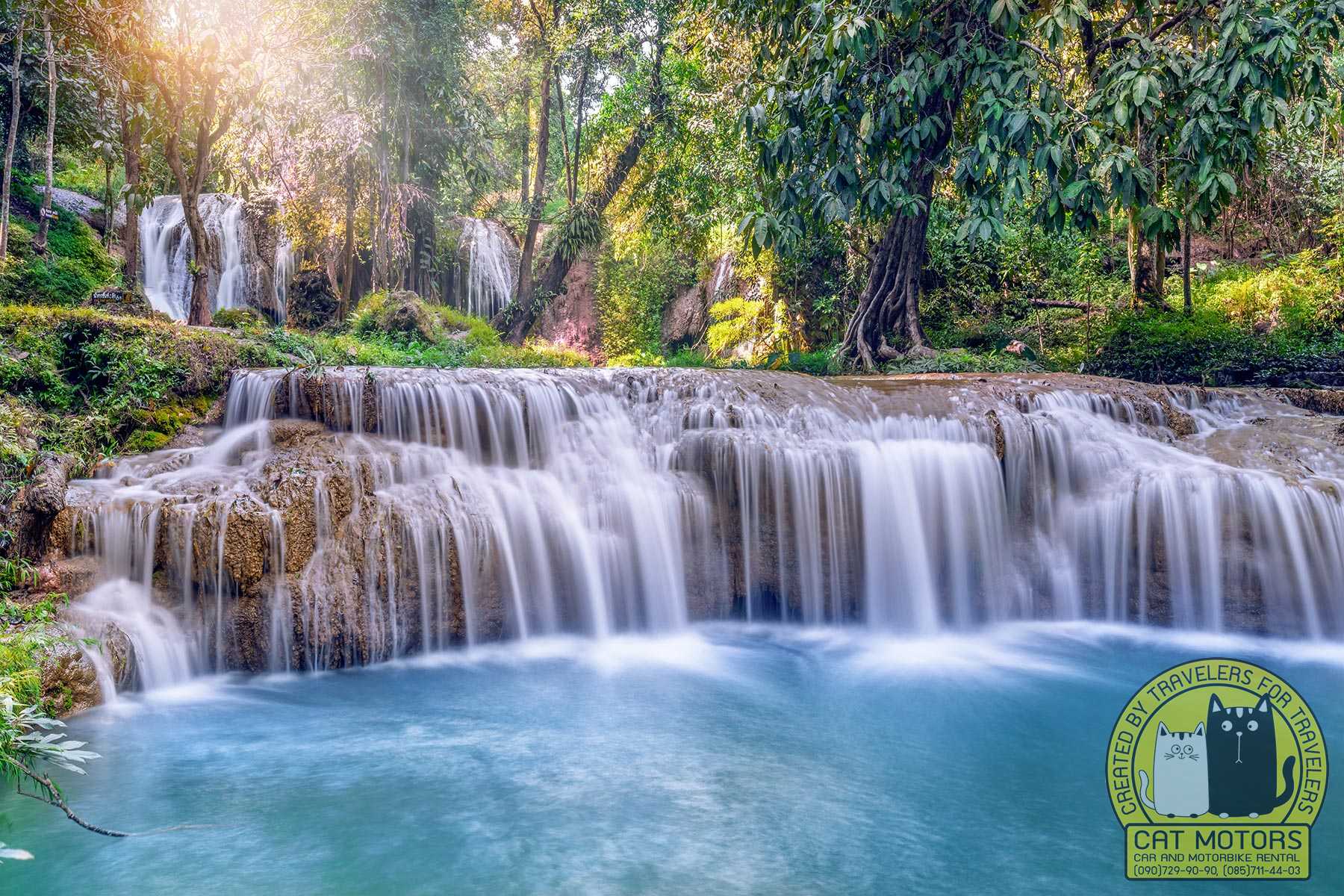
Some of the highlights of Doi Phu Nang National Park include:
-
- Than Sawan Waterfall: A picturesque medium-sized limestone waterfall with four tiers. Fed by mountain streams, Than Sawan tumbles over rocks into emerald pools. It’s surrounded by thick greenery and is a popular spot for family picnics and a refreshing dip – after a short trail from the parking area, you’re rewarded with the sight and sound of cascading water in a cool, shady setting.
- Huai Ton Phueng Waterfall: A smaller but historically significant waterfall in the park. It has been an important water source for nearby villages, which use its spring for farming. Visiting this waterfall offers a glimpse into how local communities depend on natural water supplies for their livelihoods.
- Pang Nguen (Pang Nung) Cave: An impressive cave system within the park that contains five halls and can accommodate many visitors at a time. Inside, you’ll find striking stalactites and stalagmites that glisten when light hits them. Guided tours or a ranger accompaniment might be available – it’s best to have a flashlight and proper shoes, as the cave interior can be slippery. The cave is a cool refuge on a hot day and an interesting geological attraction.
- “Dinosaur” Forest Park: A unique aspect of Doi Phu Nang – a site where dinosaur fossils (specifically a sauropodomorph dinosaur bone) were discovered in 2022. This find is significant as it’s the only dinosaur excavation site in Northern Thailand. The area, sometimes called Dinosaur Kangluang Forest Park, now displays these prehistoric remains and adds a bit of paleontological intrigue amidst the natural setting. It’s a fun stop for families or anyone interested in ancient history.
Additionally, Doi Phu Nang’s forests are home to a population of wild green peafowl (peacocks), which the park actively protects. The sight of these elegant birds with their long iridescent tail feathers in the wild is truly memorable. Early morning or late afternoon near open areas or waterways can be the best times to spot them, especially during breeding season when the males display their plumage.
The park has facilities like a visitor center, campsites, and some simple bungalows. There are nature trails for hiking, and given the park’s size, one could easily spend a full day or more exploring. Doi Phu Nang is accessible via the Chiang Muan district of Phayao – the roads wind through scenic mountain terrain, and getting here is part of the adventure.
For those who make the journey, Doi Phu Nang National Park offers a diverse array of natural attractions – from waterfalls and caves to wildlife and even dino fossils – truly showcasing the variety that this province’s wilderness holds.
Wat Si Khom Kham
Situated on the southwest shore of Phayao Lake, Wat Si Khom Kham is the province’s most important temple and a site that beautifully reflects the spiritual heritage of the area. The temple is often simply called Wat Phra Chao Ton Luang, after its most famous feature: the enormous Buddha statue enshrined here named Phra Chao Ton Luang. This Buddha image is the largest statue in the Lanna style in northern Thailand, dating back to 1491 AD (B.E. 2034). At about 16–18 meters tall, gilded and seated in the classic posture of subduing Mara, it is awe-inspiring when you step into the temple’s main viharn.
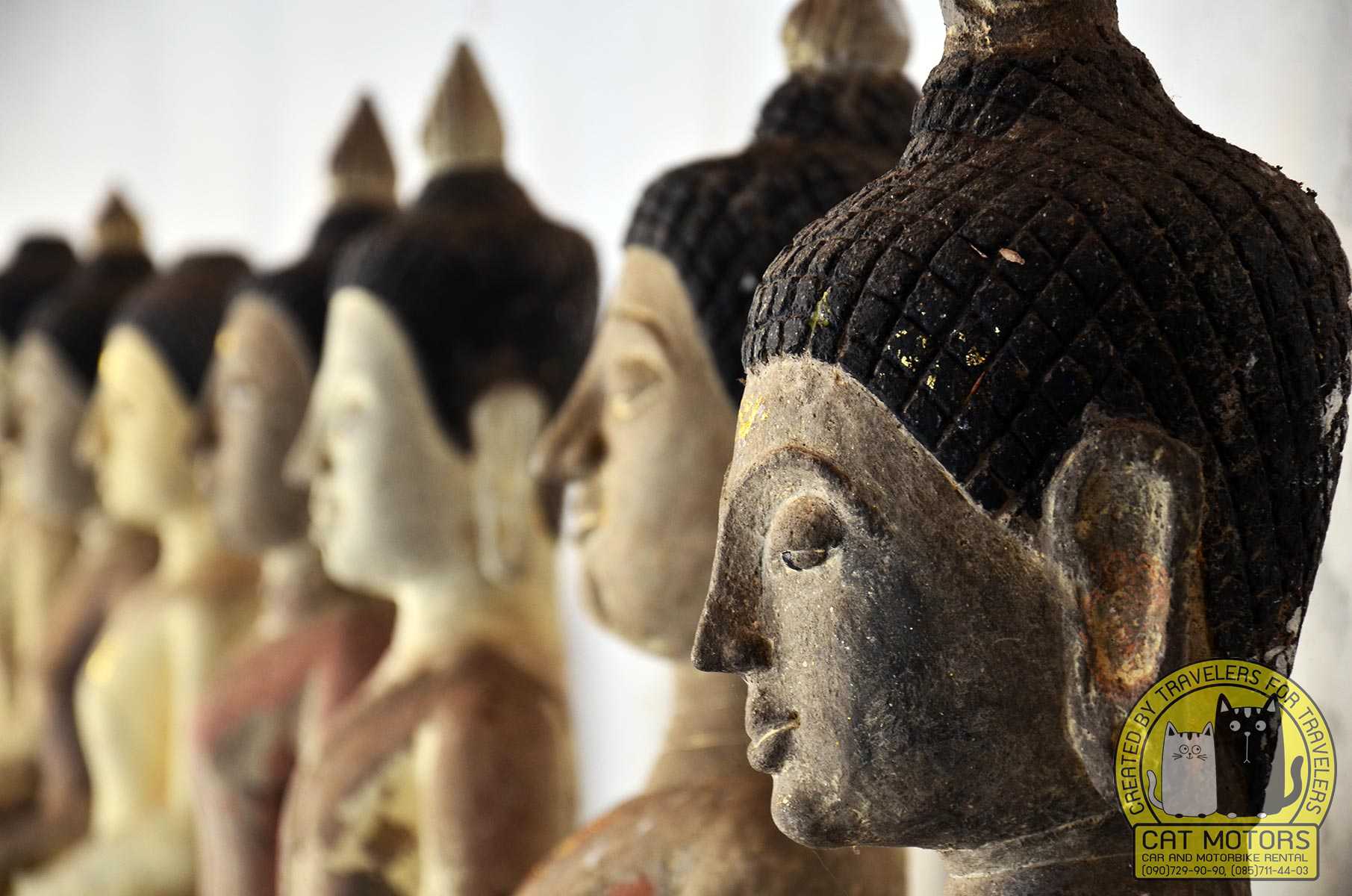
Phra Chao Ton Luang took 33 years to complete and is revered as the most sacred Buddha image in Phayao. Locals attribute protective and even miraculous powers to it, and pilgrims come from all over northern Thailand to pay respects. When you visit, you’ll notice the faithful kneeling or applying gold leaf to smaller statues, with the soft murmur of prayers in the background. Despite the temple’s importance to locals, it maintains a welcoming atmosphere for visitors.
The viharn (prayer hall) housing the great Buddha is an impressive structure with ornate Lanna architecture – look for the intricately carved wooden beams and the unique sunburst motif behind the big Buddha’s head. Around the hall, you’ll find other artifacts and older Buddha statues (some several hundred years old) in niches along the walls. The overall feeling inside is one of peace and antiquity, with motes of dust dancing in sunbeams that illuminate the statue’s serene face.
Wat Si Khom Kham’s compound offers more to see. Toward the lake is a striking structure called Phra Ubosot Klang Nam (the “ubosot in the middle of water”). This ordination hall is built on a platform in an artificial pond, giving the illusion that it floats on the lake. It’s a modern structure (not from the Lanna period) but very photogenic, and it symbolizes purity by being surrounded by water. If you walk behind this hall, you get a lovely view of Phayao Lake – an excellent spot for photos, especially at sunset.
Another reason people visit Wat Si Khom Kham is for the temple fair during Visakha Bucha Day (around May). This important Buddhist holiday (commemorating the Buddha’s life) draws large crowds to the temple for ceremonies and a vibrant festival. If you happen to be in Phayao at that time, it’s a cultural experience not to miss – with lantern processions, lots of food stalls, and traditional performances around the temple grounds.
Open daily and free to enter (donations are welcome), Wat Si Khom Kham is absolutely a must-see. Whether you are religious or not, the temple offers insight into the region’s history and art. Standing before the immense Phra Chao Ton Luang, feeling the cool breeze off the lake, you get a sense of the enduring faith and artistry that have shaped Phayao’s identity.
Wat Nantaram
In the small town of Chiang Kham (northern Phayao province), the exquisite Wat Nantaram awaits those interested in unique temple architecture. This temple is a shining example of Shan (Tai Yai) craftsmanship – a style quite different from typical Thai temples and more akin to what you’d find in Myanmar’s Shan State. In fact, Wat Nantaram is often hailed as one of the most beautiful Shan-style temples in Thailand.
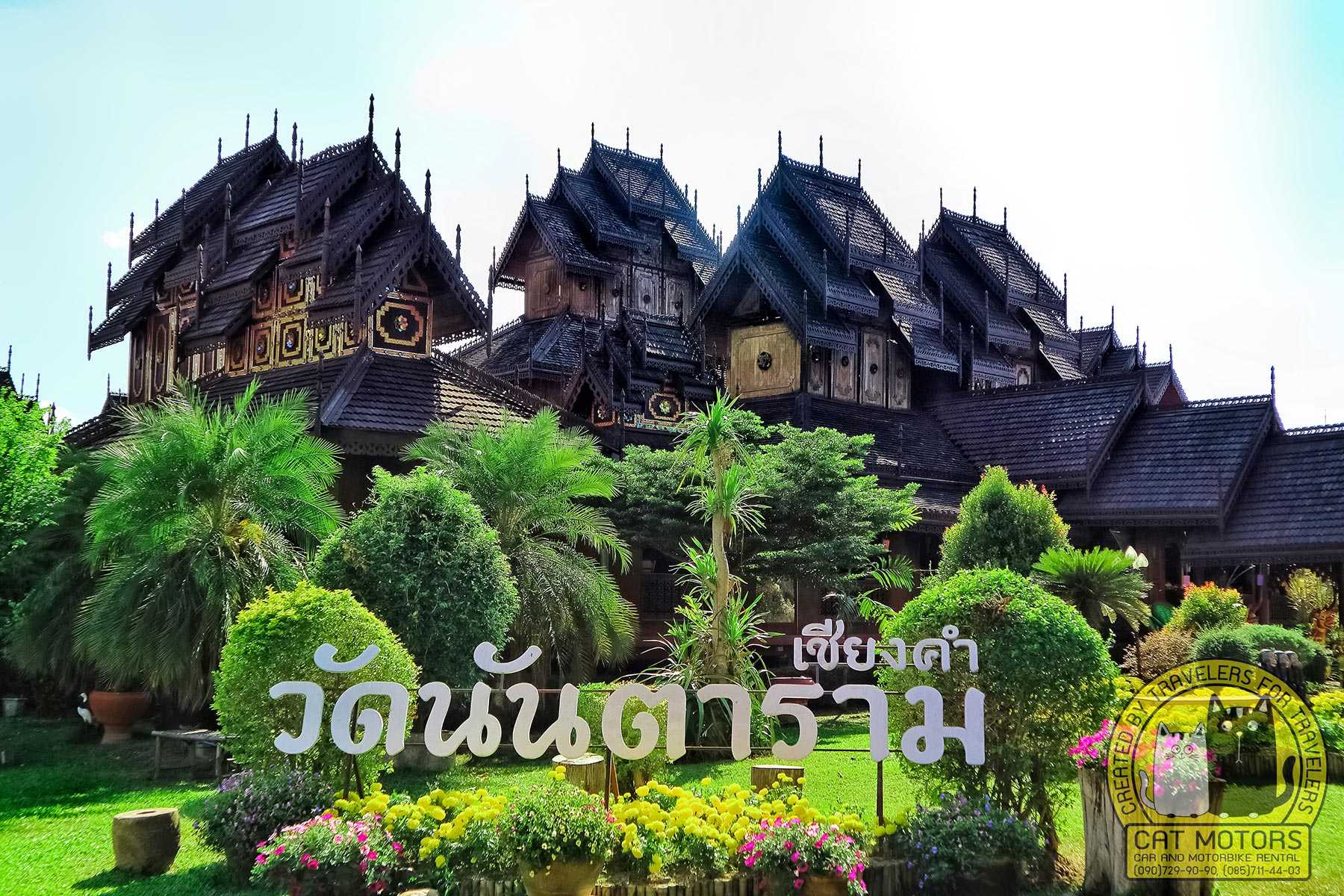
What immediately grabs your attention is that the temple is constructed almost entirely of teak wood. The central assembly hall (viharn) is a sprawling teak structure built in the early 20th century, with a multi-tiered roof that cascades down in ornate layers. The roof tiers are decorated with intricate woodcarvings and fretwork; at the gable ends you’ll see stylized wood mosaics and mirrors that catch the sunlight. This grand wooden architecture stands in contrast to the more common stone or concrete temples elsewhere, giving Wat Nantaram a warm, earthy presence. It almost feels like a living museum of woodwork.
Stepping inside, you’re surrounded by the golden-brown hues of aged teak pillars and panels. The interior is filled with antique artifacts and Buddha images. On the main altar sits a large Shan-style Buddha carved from teak, flanked by others made of bronze and various materials. All around are displays of smaller antique Buddhas, some weathered with age. Nearly every inch of wall and ceiling is embellished – you’ll find carved bas-reliefs, lacquered designs, and shimmering glass inlay pieces catching the light. Be sure to look up at the ceiling for unique decorations. The craftsmanship is astounding; it’s clear Shan artisans put immense skill and devotion into this place.
Despite looking like a well-curated museum, Wat Nantaram is very much an active monastery. Monks live here and locals come daily to pray. As a visitor, you should dress modestly and move quietly, as the ambiance invites contemplation. The monks are used to visitors and may offer a gentle greeting. Photography is allowed (preferably without flash) – you’ll definitely want to capture the artistry, but do so respectfully.
Around the compound there are a couple of additional structures: another building with reliefs depicting the Buddha’s life, and an ubosot (ordination hall) across from a two-toned white-gold stupa. These are interesting, but the wooden viharn is the star. Outside, during the day, the teak wood gives off a pleasant aroma, and the gardens are well-maintained with tropical plants adding splashes of green around the dark wood.
Wat Nantaram offers a peaceful, almost nostalgic journey into the past. It reflects the influence of Shan people who migrated to this area over a century ago and left an indelible mark on the cultural landscape. Visiting this temple is highly recommended, especially if you have an interest in architecture or the cultural tapestry of Northern Thailand. It’s a bit off the main route (Chiang Kham is about 80 km from Phayao city), but absolutely worth the detour to witness this wooden masterpiece.
Wat Phra Nang Din
About 5 km south of Chiang Kham (not far from Wat Nantaram), Wat Phra Nang Din is a charming temple with a fascinating legend. Its name translates to “the Buddha on the ground,” and indeed the temple’s claim to fame is a sacred Buddha image that, very unusually, sits directly on the earth rather than on a pedestal. According to local lore, this bronze Buddha statue was cast about 500 years ago. Villagers tried to lift it onto a customary altar multiple times, but each time the statue seemed impossibly heavy and could not be raised. Interpreting this as the Buddha’s will, they left the image on the ground – hence the name Phra Nang Din, the Buddha who prefers to remain grounded.
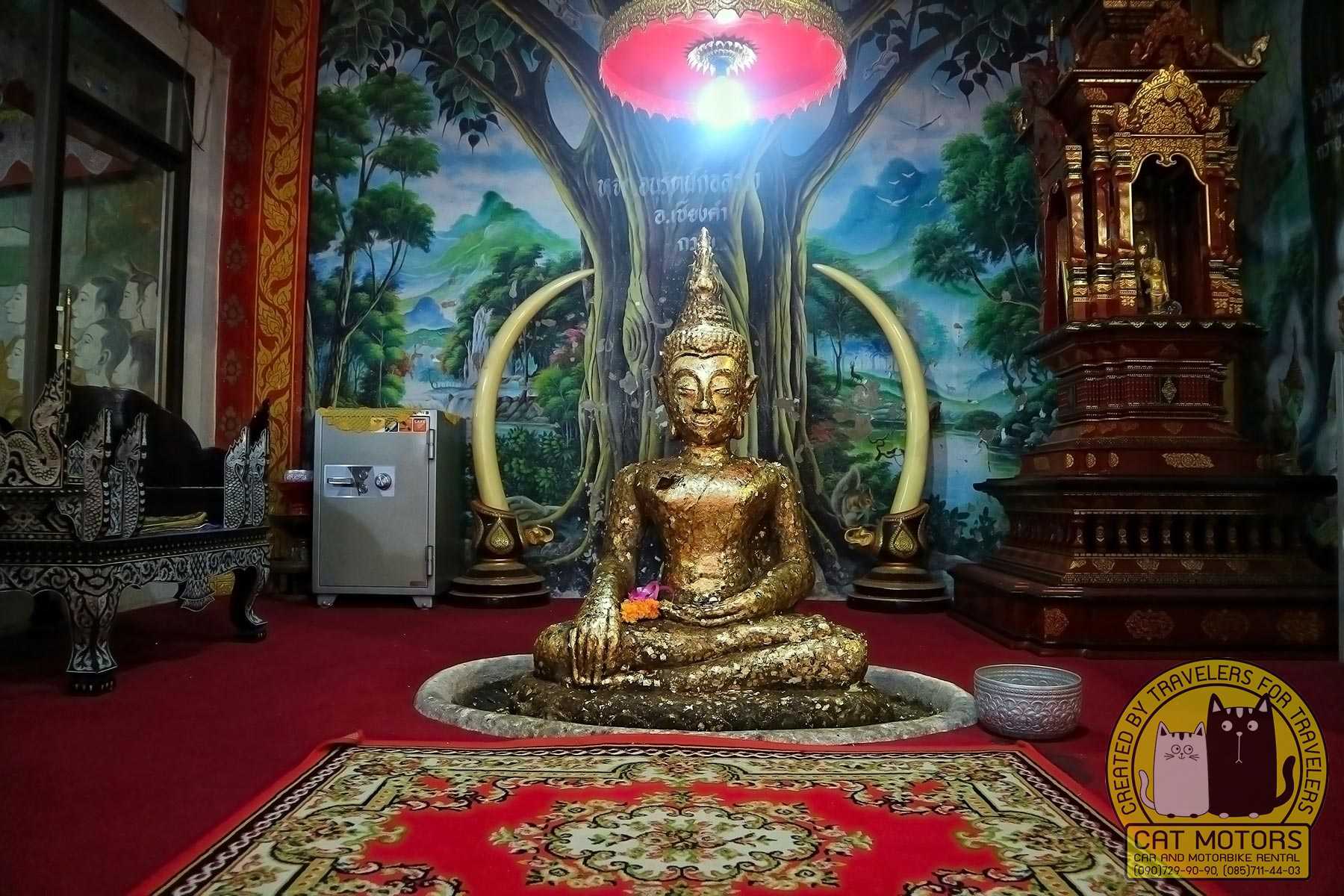
Today, visitors to Wat Phra Nang Din can see this special image housed in a modest viharn. The Buddha is relatively small, made of dark bronze and seated directly on the temple floor with offerings lovingly arranged around it. Locals hold it in high reverence, believing it protects the area and grants blessings, especially since it has “chosen” to stay connected to the earth. It’s common to see people kneeling on the floor in front of the image and even placing their foreheads to the ground as they pray – a gesture of humility reflecting the Buddha’s own position.
Beyond the legend, Wat Phra Nang Din is a pleasant rural temple to explore. The grounds are peaceful, with a large bodhi tree and typical temple structures. There’s an old brick chedi on site that some say dates back several centuries. The temple is not at all touristy; you might be one of only a few visitors, giving it an intimate feel. You can take your time absorbing the story and perhaps chat with the local caretaker or a monk about the temple’s history. Some locals will share that the term “Phra Nang Din” has even become an honorific nickname for Phayao province itself, symbolizing the province’s grounded and humble nature.
Visiting Wat Phra Nang Din is straightforward – there’s no entry fee, just the expectation of polite attire and behavior. While it might not wow you with grandeur, the temple offers a delightful slice of folklore and faith. After seeing many Buddha images raised high on pedestals across Thailand, there’s something endearing about this one quietly sitting on the temple floor. It embodies the idea that enlightenment and goodness are not above us but right here on the ground amongst us. If you’re touring Chiang Kham’s attractions, be sure to stop by this temple to round out the experience.
Mae Puem National Park
Straddling the border of Phayao and Chiang Rai provinces, Mae Puem National Park is a scenic natural area centered around the Mae Puem Reservoir. For travelers, it’s a great spot for a day of relaxation, picnicking, or camping by the water. The park’s landscape is a mix of gentle forested hills, grassy meadows, and a large serene reservoir that shimmers under the sun.
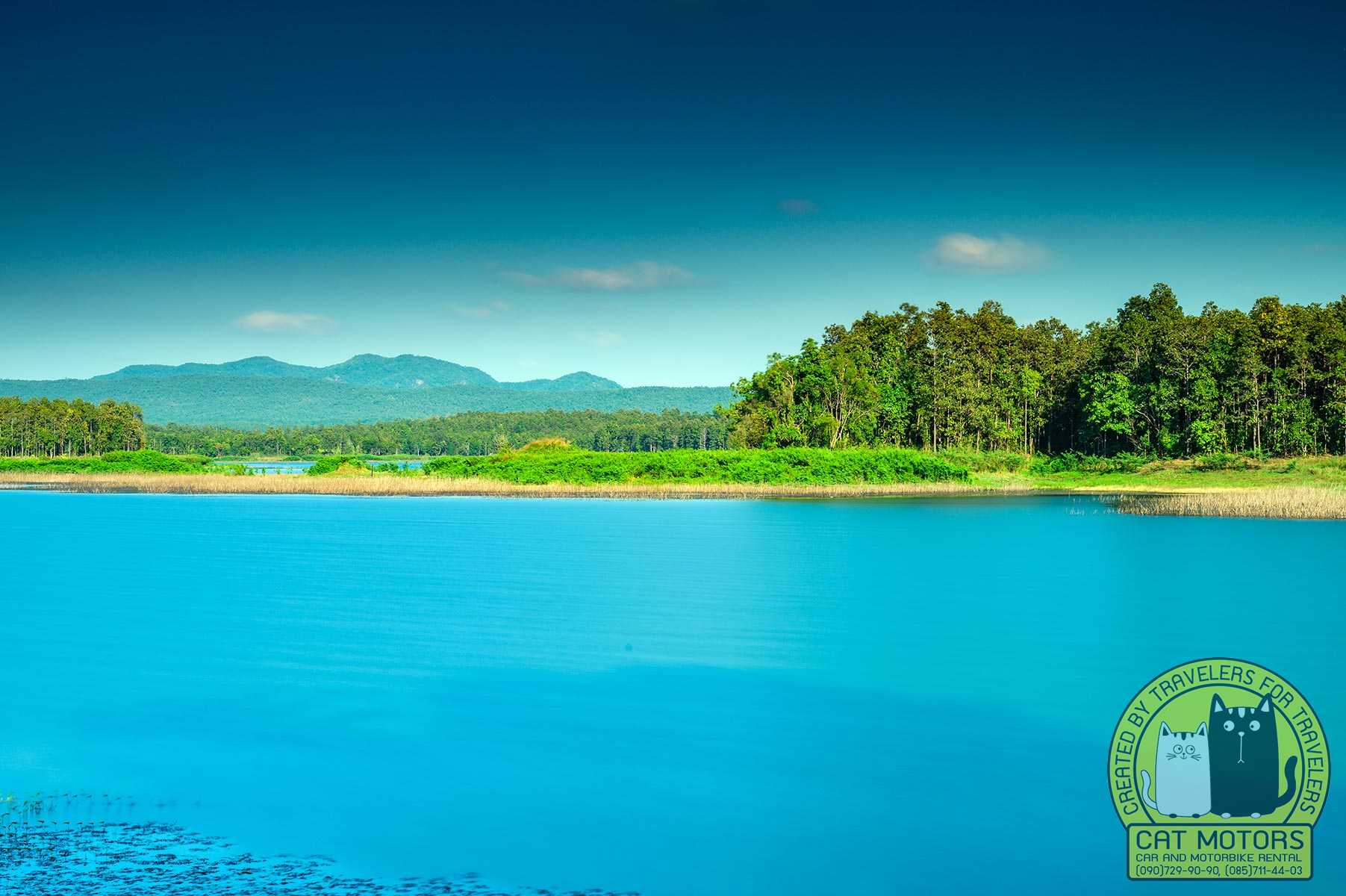
One of Mae Puem’s main draws is its accessibility and family-friendly setup. There’s a designated camping area right by the reservoir’s banks, complete with basic facilities. Waking up to mist over the water and birds chirping is a refreshing experience if you camp here (tents can often be rented from the park office, or you can bring your own). Even if you don’t camp, many locals drive in for the day to enjoy nature. You’ll find people fishing in the reservoir (it’s known for snakehead fish and tilapia), groups of friends having a barbecue, and families playing in the open fields near the water. On weekends it has a laid-back, joyful atmosphere with local people enjoying their time off.
The reservoir itself was created by damming the Mae Puem River and has since become the centerpiece of the park. You can stroll along parts of the lakeshore; in December/January the weather is wonderfully cool – even a bit chilly in the mornings, giving an almost alpine feel. During these winter months, the air is crisp and you might see wildflowers blooming in the meadows. It’s an ideal time for a picnic or gentle hike. The park has a few nature trails where you can see local flora (teak forests) and perhaps spot wildlife like squirrels, waterfowl, or lizards. There are also observation points around the lake, perfect for photography or simply soaking in the panoramic views.
Mae Puem is not very well known among international tourists, which is actually a plus – it means the park is seldom crowded. It feels like a secret retreat where you can breathe fresh air and enjoy simple pleasures. If you’re up for a bit of exercise, consider renting a bicycle (if available) or just walking the quiet park roads that wind along the water’s edge.
Mae Puem National Park is located roughly 50 km from Phayao town (and about 20 km from Phan in Chiang Rai). It’s easy to reach by car or motorbike via Highway 1 and then a short detour. While it doesn’t have dramatic mountains or big waterfalls, it offers serenity and a chance to unwind in nature. For travelers heading between Phayao and Chiang Rai, Mae Puem makes a nice stopover; for those spending more time in Phayao, it’s yet another example of the province’s varied outdoor offerings – from lakeside fun to forested tranquility.
Doi Luang & Doi Nok (Phayao’s Peaks)
For adventure seekers and trekkers, Doi Luang (1,694 m) and Doi Nok are two prominent peaks that dominate Phayao’s skyline and promise sweeping vistas to those who summit them. They are part of the Doi Luang National Park which extends into Phayao. Climbing these mountains is a rewarding challenge and offers one of the best panoramic viewpoints in the region.
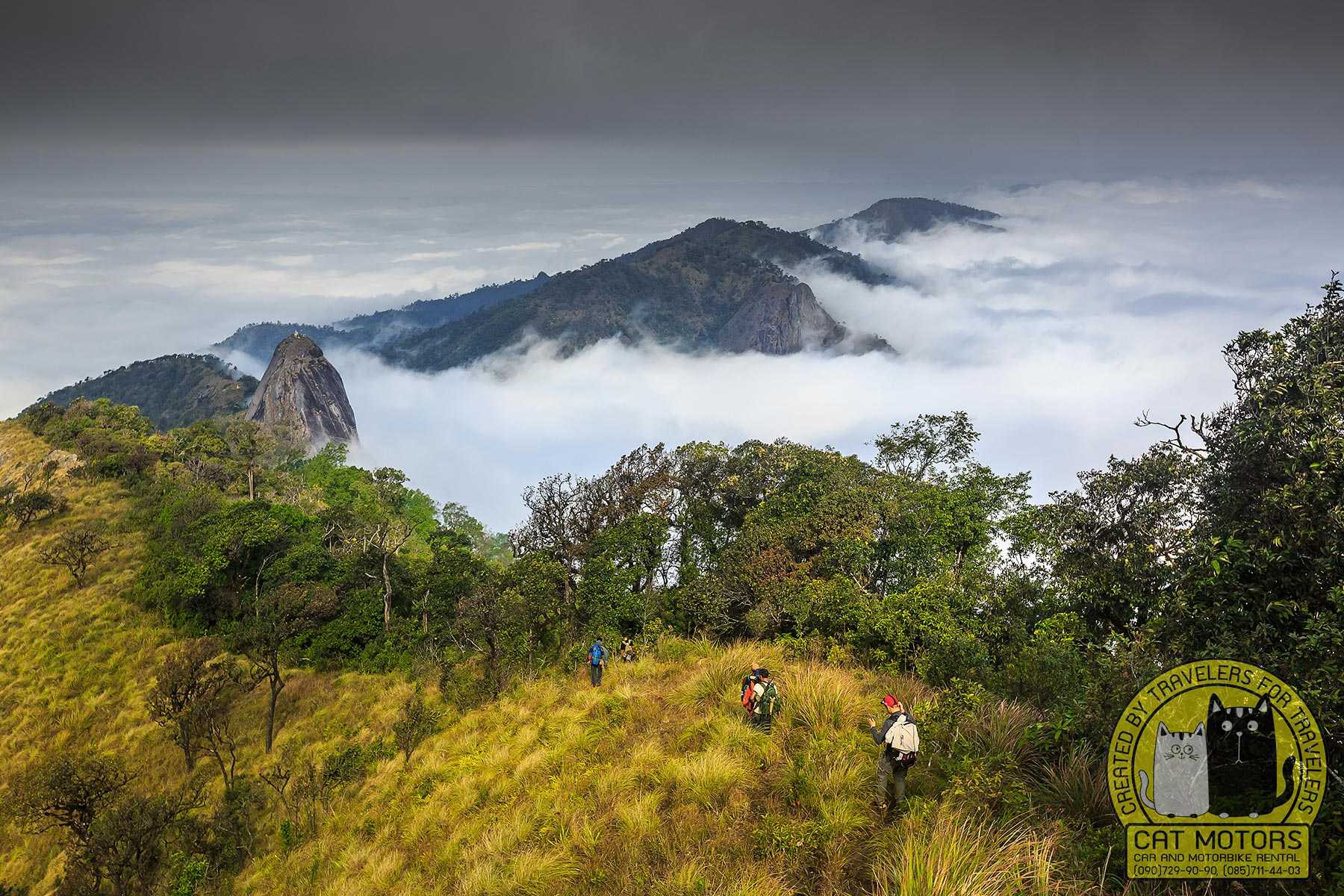
Doi Luang (meaning “big mountain”) is the tallest mountain in Phayao. The trek to the top is typically done with the assistance of park guides and usually involves camping overnight. It’s not an easy hike – expect to traverse steep jungle trails and perhaps scramble over rocky sections – but the effort is absolutely worthwhile. From the summit, you get a 360-degree panorama: on clear days you can see all of Phayao, including Kwan Phayao Lake glinting in the distance, the town nestled by the water, endless forests, and even into neighboring provinces. Reaching the summit at sunrise is popular; hikers often start in the pre-dawn hours or camp near the top to catch the first light. In the cool season, a “sea of mist” often fills the valleys below, leaving just the mountaintops poking through a sea of clouds – an unforgettable sight. In the distance, other peaks of the Phi Pan Nam Range create a horizon of rippling blue silhouettes.
Adjacent to Doi Luang is Doi Nok (meaning “bird mountain”), a slightly lower peak crowned by a small golden pagoda known as Chedi Phra That Doi Nok. Many Northern Thais consider it a sacred spot and make the journey to pay respects and receive blessings at the mountaintop chedi. If you’re climbing Doi Luang, Doi Nok is often included in the itinerary, or some hikers aim for Doi Nok specifically if they want a shorter trek. The views from Doi Nok are also spectacular – imagine looking out over an ocean of clouds or verdant valleys with a gleaming pagoda in the foreground. It’s truly photogenic and spiritually uplifting at the same time.
Treks to Doi Luang/Doi Nok are usually organized through the national park office or local tour operators in Phayao/Chiang Rai. It’s important to go with proper guidance, as the trails can be tricky and weather unpredictable on the peaks. Typically, you’ll need to be in decent physical shape and have proper hiking gear (sturdy shoes, warm clothing for the summit, rain protection, etc.). The best time to hike is the cool, dry season (November to February) when conditions are most favorable and the chance to witness the famed morning mist is highest.
Even if you don’t climb these mountains, their presence is felt throughout Phayao – look toward the horizon from the city and you’ll see Doi Luang standing proudly. But for those who do venture up, standing atop the province’s highest peak is an unforgettable experience, giving you both a literal and figurative overview of this beautiful region.
Mae Tam Reservoir
Mae Tam Reservoir is a tranquil artificial lake located a short drive south of Phayao town. It might not be on every tourist’s radar, but it’s a favorite leisure spot for locals and offers a pleasant outing, especially in the late afternoon. The reservoir was created as part of a Royal Irrigation Project, and it’s one of the largest in Northern Thailand, capable of holding about 37 million cubic meters of water.
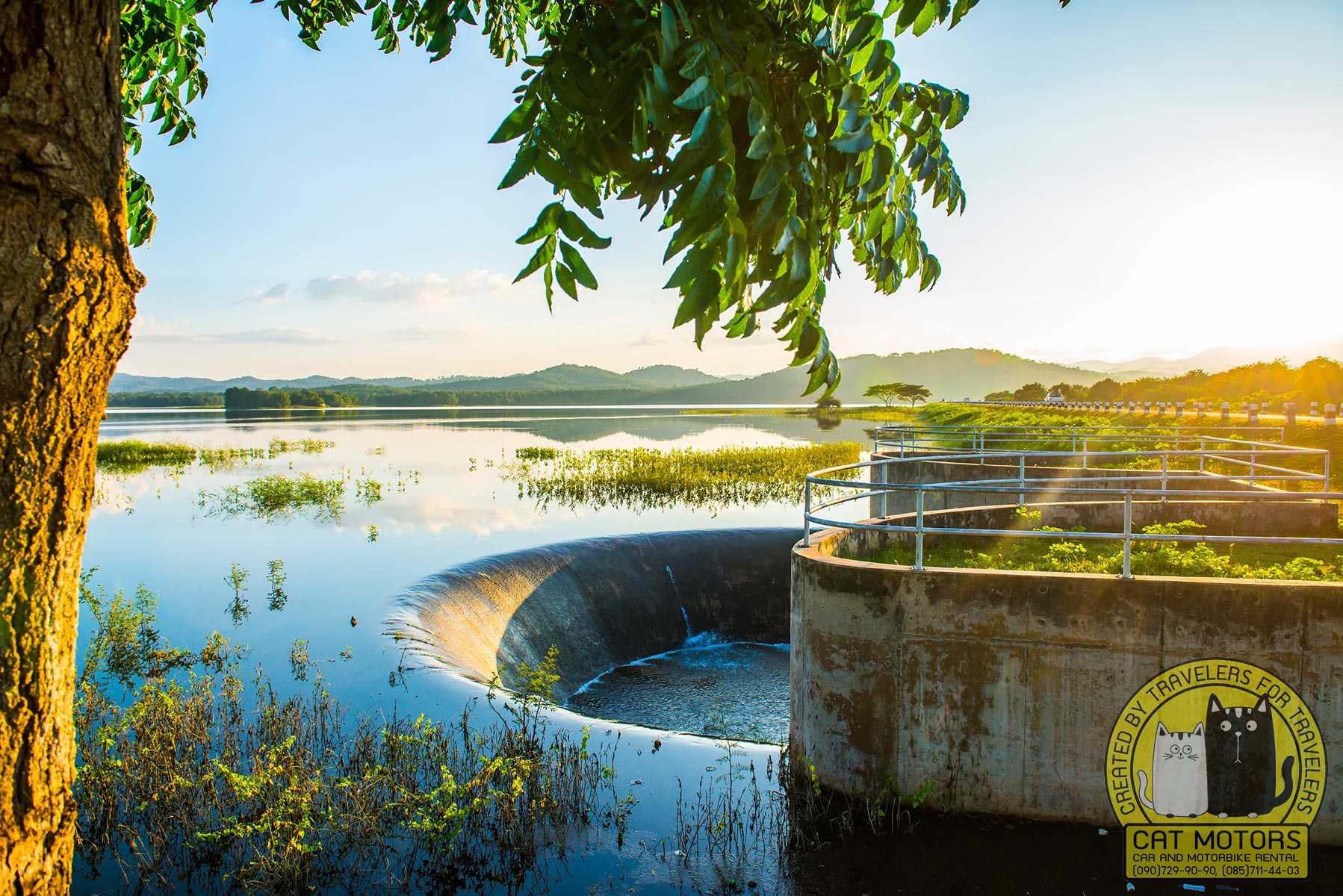
The setting of Mae Tam is picturesque – it’s encircled by gentle hills and backed by the silhouettes of distant mountains. In the cool season, the surrounding landscape is green and dotted with wildflowers and tall grasses; in the dry season, the water level recedes a bit, revealing wider sandy banks perfect for walking. One of the best times to visit Mae Tam is toward sunset. This spot is known for some of the most stunning sunsets near Phayao: as the sun dips low, the sky often turns brilliant shades of orange and purple, and the reservoir’s water reflects these colors beautifully. The peaceful ambiance and open space make it great for couples or friends to sit and relax – indeed, it’s sometimes touted as a romantic hangout in the evenings.
There are a few simple amenities around. You’ll find picnic shelters, a fishing pier or two, and sometimes local vendors selling grilled chicken, som tam (papaya salad), or drinks – especially on weekends when more people come out. You might see families having picnics or local youths perched on motorbikes along the dam road enjoying the breeze. It’s also a nice spot for a bit of casual birdwatching; various water birds and migratory birds visit the reservoir. If you enjoy fishing, local fishermen often cast their lines here for tilapia and other freshwater fish (bring your own gear if you want to try).
Getting to Mae Tam Reservoir is easy by vehicle – it’s roughly 15 km from Phayao town. Once there, you can drive along the top of the dam that impounds the reservoir. There’s no entrance fee or official gate; it’s an open public area. Because the reservoir is part of an irrigation project, you’ll also notice agriculture thriving in nearby fields – rice paddies and cornfields benefit from its waters.
In sum, Mae Tam Reservoir is about enjoying simple pleasures. It’s not an adrenaline-pumping attraction, but if you appreciate nature’s calm and scenic beauty, it’s worth spending an hour or two here. Bring some snacks or a picnic, maybe a blanket, and enjoy a quiet sunset by the water – it’s a restorative experience that nicely balances the more active sightseeing elsewhere.
Phu Klong Hill Vineyard
Phu Klong Hill Vineyard (sometimes called Phuklong Hill Farm) is a delightful multi-purpose attraction in Phayao that combines agriculture, leisure, and photography into one scenic stop. Don’t let the word “vineyard” fool you into thinking it’s only rows of grapes – Phu Klong Hill is much more than that. This expansive hillside estate was originally a rubber plantation, but it has been transformed into an all-in-one park featuring vineyards, flower gardens, orchards, a small water park, farm animals, and even accommodation.
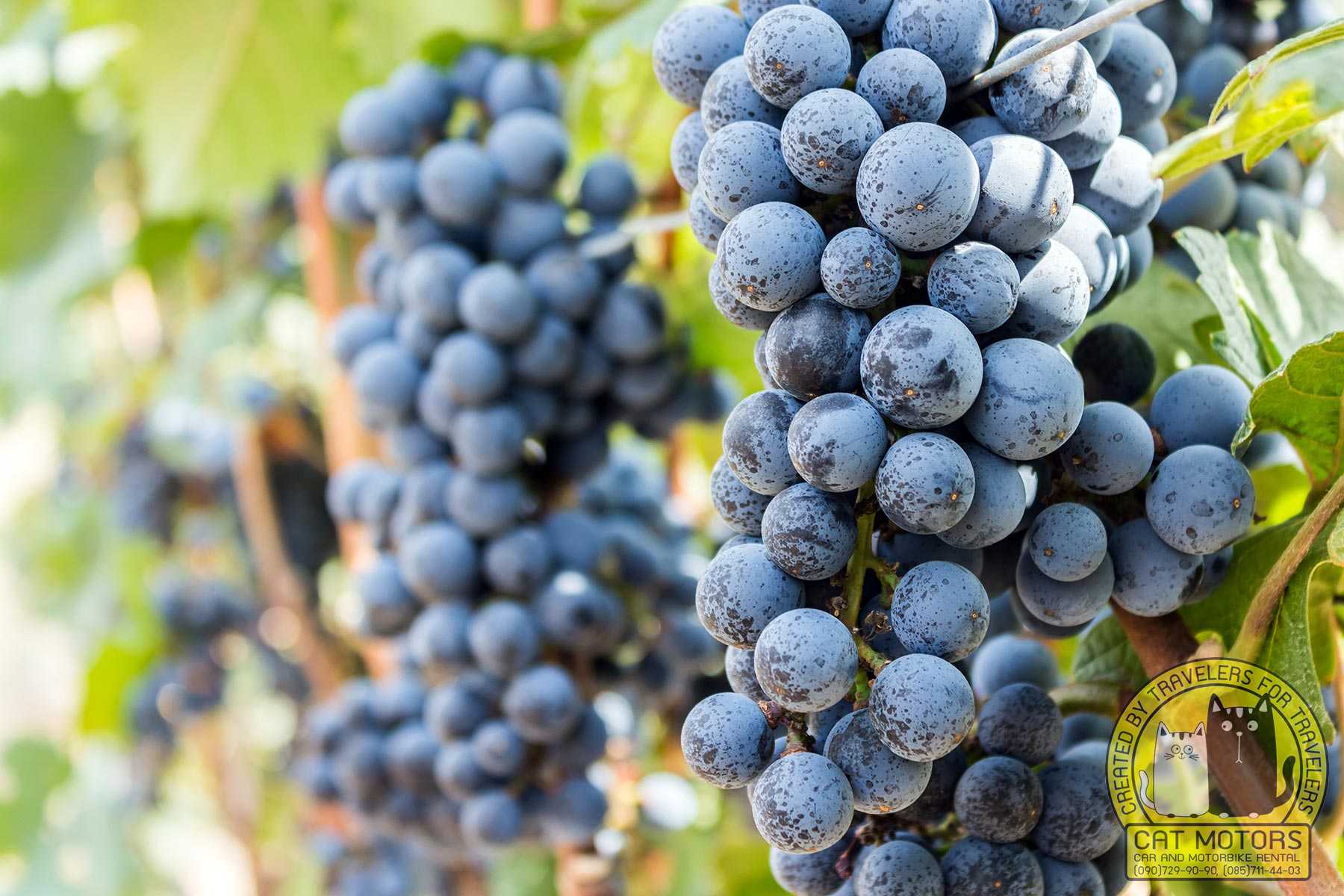
One of the main draws is indeed the vineyard and winery aspect. You can walk through neat rows of grapevines – especially picturesque in the cool season (Nov–Jan) when bunches of grapes hang ready for harvest. The farm produces fresh grape juice and other grape products (and even some local wine) which you can taste or buy – a refreshing treat on a warm day. But what often excites visitors even more is the sheer variety of activities on offer here.
Phu Klong Hill features beautifully landscaped flower gardens that burst into color during the winter months (roughly Nov–Jan). Rows of sunflowers, marigolds, celosia and other blooms carpet the hillsides, and the management has set up cute props and photo frames around the gardens to make the most of the scenery. It’s an Instagram paradise – everywhere you turn is another photo opportunity with vibrant flowers and mountain backdrops.
For families, Phu Klong Hill is a mini-paradise. There’s a small water park area with a pool and water slides – a hit with kids looking to splash around. Scattered around the property are animal enclosures: you might meet friendly sheep, see deer grazing, spot rare albino peacocks displaying their feathers, or chat with cockatoo parrots in the mini-zoo section. These interactive elements make it fun for children (and adults young at heart). Often you can buy small baskets of feed to give to the animals – always a delight for little ones.
Phu Klong Hill also has a restaurant and café on-site. Many visitors plan to have a meal here – the restaurant serves Thai dishes and some Western fare, often incorporating organic veggies and ingredients grown on the farm. Enjoying lunch with a view of rolling hills and flower beds is quite relaxing. There’s also a farm shop where you can buy organic vegetables, fruits, and souvenirs like homemade jam or wine.
If you’re particularly charmed by the place, you can stay overnight. There are a few rustic resort bungalows with views of the vineyards and gardens. Waking up to dewy flower fields and perhaps joining a morning farm activity can make for a pleasant rural retreat vibe.
Phu Klong Hill is located roughly 20 km from Phayao town, so it’s best visited with your own transport or as part of a tour. It’s especially popular in the cool season – during December and January, many Thai tourists come specifically for the flowers and the cool breeze. The entry fee is modest and helps maintain the park (and the photogenic flower displays).
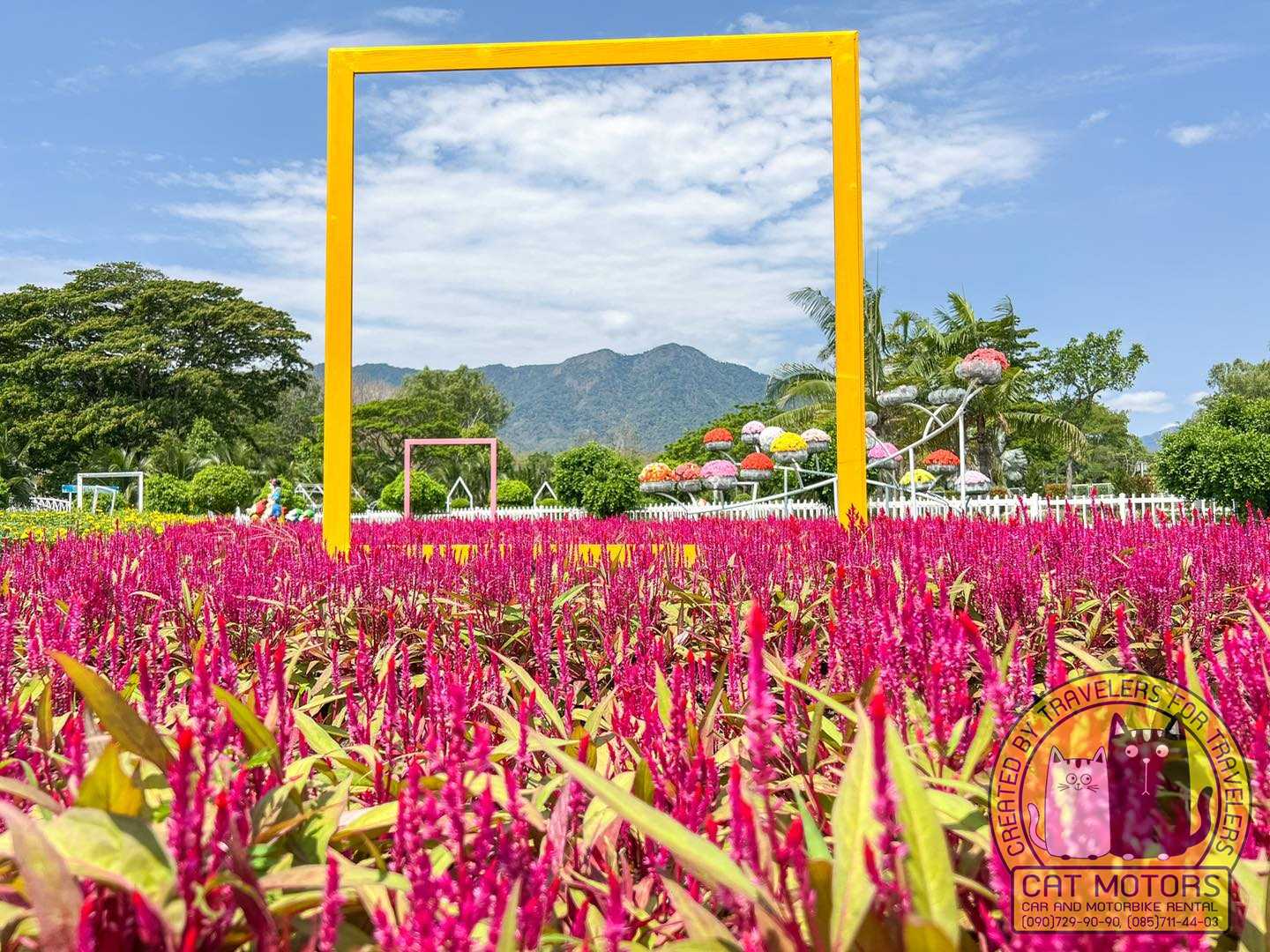
All in all, Phu Klong Hill Vineyard offers a refreshing change of pace: you can slow down, breathe in the scent of flowers, taste fresh grape juice, enjoy fun activities, and snap gorgeous photos all in one place. It showcases a more modern, creative side of Phayao – where agriculture meets tourism – done in a way that’s entertaining yet in tune with nature. Don’t forget to try their grape juice (or a locally made wine) and take in the panoramic views from the hilltop over the patchwork of gardens.
Mae Saeng Da Thai Lue House Museum
Phayao province is home to a significant Thai Lue community – an ethnic group with roots in southern China that migrated to northern Thailand centuries ago. To experience Thai Lue culture firsthand, head to the Mae Saeng Da Thai Lue House (Thai Lue House Museum) in Chiang Kham district. This living museum is essentially a preserved traditional Thai Lue wooden house and community center that celebrates the art, culture, and lifestyle of the Thai Lue people.
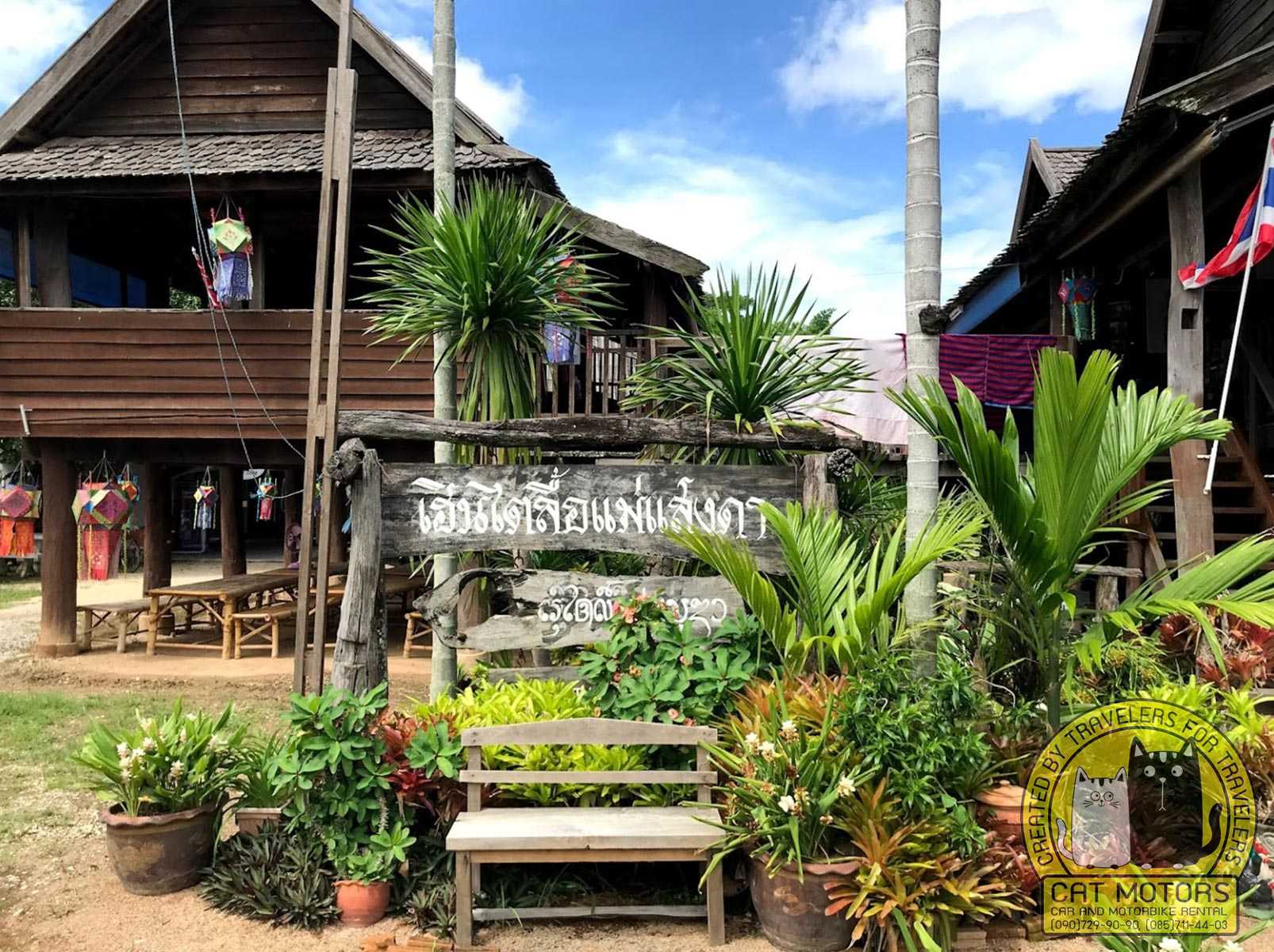
When you arrive, you’ll notice the distinctive architecture: the house is built on stilts, made entirely of wood, with a high, steeply pitched roof. Stepping inside is like stepping back in time. The house is filled with traditional items – antique looms for weaving, folk costumes, wooden rice barns, and everyday tools used by the Lue people in the past. Members of the local community often act as guides, showing visitors around. You’ll learn about the Thai Lue’s renowned weaving skills; this group is famous for their handwoven textiles, especially their geometric-patterned weaves in indigo and red. In fact, one highlight is seeing (or even trying) traditional cotton weaving on a loom. The locals happily demonstrate how they spin cotton, dye threads naturally, and weave intricate fabrics with techniques passed down through generations.
Aside from the house itself, the cultural immersion continues with the people. Thai Lue villagers often dress in their gorgeous traditional attire – typically dark blue indigo shirts and patterned sarongs. Their warm welcome makes the visit special. They might offer you herbal tea and show you around the compound, which includes a small collection of artifacts. Sometimes, if you’re lucky, they perform a local dance or music. There’s also a shop area where you can purchase handmade textiles like scarves, shirts, bags or other handicrafts made by the community – a wonderful way to support their craft and take home a meaningful souvenir.
Visiting Mae Saeng Da is not just about observing, but also engaging. If you have time (and arrange in advance), you can participate in workshops – perhaps learning basic weaving or even cooking a Thai Lue dish. The aim of the community is to preserve their heritage and educate younger generations and visitors alike. By engaging with them, you’re helping sustain these efforts; any fees or donations you provide go toward maintaining the museum and supporting local artisans.
The site is a bit off the beaten path, located in a village outside Chiang Kham town (about 80 km from Phayao city). However, if you’re touring the northern part of Phayao (maybe visiting Wat Nantaram and other Chiang Kham sights), it’s easy to include this stop. There are typically signs in English pointing to the “Thai Lue House” from the main roads.
In summary, the Mae Saeng Da Thai Lue House offers an authentic cultural experience. It’s enlightening to see how the Thai Lue have retained their distinct identity – from architecture and clothing to weaving and festivals – even as the modern world encroaches. Spending an hour or two here provides a deeper understanding of the province’s cultural mosaic and the importance of community-led heritage preservation. You’ll likely leave with a great appreciation for the Thai Lue people…and perhaps a beautiful handwoven textile or two in your bag.
Wat Analayo Thippayaram
Set atop the forested Doi Busarakham hill on the western side of Phayao Lake, Wat Analayo Thippayaram is a sprawling temple complex that feels almost like a mystical “temple city” in the woods. Often simply called Wat Analayo, it was developed in the late 20th century by a revered monk, but it incorporates architecture and art that span many styles and eras of Buddhism. Visiting Wat Analayo is like embarking on a spiritual treasure hunt – around each bend of the path, you’ll discover something unexpected: a graceful Buddha statue beneath a tree, an elegant Thai pavilion, or perhaps a replica of an Indian stupa.
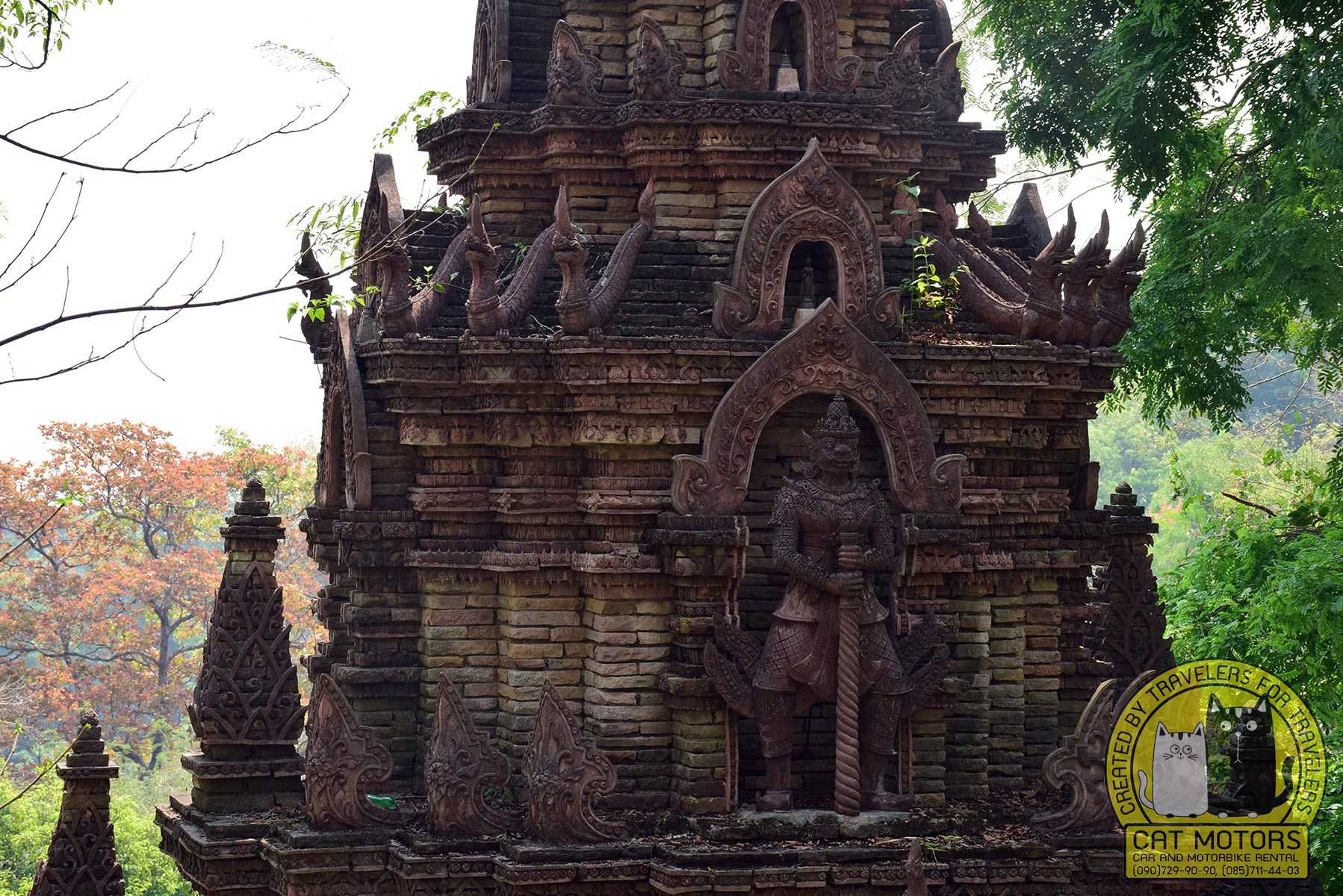
One of the first things to know is that Wat Analayo is huge – it covers dozens of hectares on the hillside. The complex is connected by roads and walking trails, and you could easily spend half a day exploring. Many people drive partway up and then walk to see specific sections. Among the highlights are a beautiful arched entrance gate that greets you as you ascend, a replica of the Mahabodhi Temple (the famous temple in Bodh Gaya, India where the Buddha attained enlightenment) complete with detailed reliefs, and numerous shrine halls housing images of the Buddha in different postures and artistic styles (Thai, Indian, Chinese, etc.). There is even a large white statue of Guan Yin (the Chinese goddess of mercy) looking serenely over the trees, showcasing the temple’s inclusive approach to Buddhist art from various cultures.
Despite the variety of structures, the complex is unified by its tranquil ambiance. The shady forest setting gives the feeling of a meditation retreat. In fact, Wat Analayo was designed as a place for meditation and spiritual practice, and many of the buildings are intentionally set apart in seclusion, connected by long naga staircases or forest paths. Don’t hesitate to wander a bit – you might find a secluded spot with a magnificent lake view, or a clearing with a circle of Buddha statues in different mudras (hand gestures) quietly hidden among the trees.
A notable area is the Emerald Buddha Hall, which contains a jade-green Buddha image, and nearby a graceful standing Buddha statue in blessing pose that is a favorite photo subject. From certain vantage points, you can glimpse Kwan Phayao and Phayao town far below, reminding you how high you’ve climbed. It’s especially lovely in the early morning or late afternoon when the light is soft and you can sometimes hear the distant chants of monks echoing through the trees.
Practical tips: There’s no entry fee, but donations are appreciated. Wear comfortable shoes as you’ll be doing a lot of walking and stair-climbing. Given the size of the site, some visitors drive to different key points (there are small lanes through the complex and little parking areas). If you go by motorbike or car, you can cover more ground, but don’t miss the experience of walking some of the forest paths – it’s part of Wat Analayo’s magic. Also, weekdays are very quiet, while Thai holidays might see more visitors coming to make merit.
Wat Analayo Thippayaram is a must-visit for those who love temples, nature, or the serene side of Thai culture. It’s a place where spiritual art and natural beauty converge. Many travelers say it ended up being the unexpected highlight of their Phayao trip – a space where one can reflect, admire, and feel a world away from everyday bustle. Make sure to bring your camera and an open heart; Wat Analayo has a way of leaving a lasting impression.
Other Attractions Worth Exploring
Wiang Lo Ancient City Ruins
Hidden among the rolling hills of Chun district, the Wiang Lo Ancient City ruins offer a journey back in time to the era of the Lanna Kingdom. Dating back several centuries, these ruins represent what once was a vibrant fortified city strategically located to oversee important regional trade routes. Today, travelers can wander the remains of impressive earthen walls, crumbling fortifications, and old temple foundations, each whispering stories of the civilization that thrived here. The site is particularly captivating for history buffs, photographers, and anyone intrigued by the secrets of Thailand’s past. Walking among the quiet ruins, now surrounded by lush greenery, you can truly sense the passage of time and feel a connection to a bygone era.
Ban Bua Village
Ban Bua is a picturesque traditional village just a short drive from Phayao town. Known as the “Lotus Village,” Ban Bua charms visitors with its authentic rural atmosphere, lush landscapes, and welcoming residents. The village is famous for preserving age-old crafts – including handwoven textiles, bamboo weaving, and pottery – that have been passed down through generations. Visitors can enjoy a leisurely stroll through the village lanes, interact with local artisans, and even try their hand at making some traditional crafts. It’s a rare glimpse into genuine rural life in Northern Thailand; far from tourist crowds, Ban Bua remains refreshingly unchanged, deeply rooted in cultural traditions. Don’t miss stopping by a local café here, where you can savor organically grown coffee or tea along with homemade snacks – a perfect way to relax and soak in the simple warmth of Phayao’s countryside.
Transportation Within Phayao
Getting around Phayao town and the wider province is easiest if you have your own vehicle, as public transport options are limited. Here are ways to travel within Phayao:
- Walking & Bicycles: Phayao Town is relatively small and flat near the lake, which makes it very walkable. Strolling the lakeside area in the evening is especially enjoyable. Bicycles are another great way to get around locally – some guesthouses offer bike rentals. A popular activity is renting a bicycle to ride along part of Kwan Phayao’s shore for scenic views.
- Tuk-tuks & Local Transport: In the town center, tuk-tuks and motorcycle taxis are available for short trips (note: there are no metered taxis here). You can hire tuk-tuks at the market or bus station to reach nearby sights. For travel between districts or villages, locals often use songthaews (shared pickup trucks with bench seating). These run on fixed routes (e.g., Phayao–Chiang Kham, or to nearby districts) but may be infrequent. There are also some inter-village buses, though they can be very slow.
- Motorbike: To truly explore Phayao’s attractions – many of which are spread out in the countryside – consider renting a motorbike or car. Having your own wheels lets you visit waterfalls, national parks, and remote temples at your own pace. Motorbike rental is popular and affordable (always wear a helmet and an international driving permit is required). Drive with caution on rural roads and mountain passes. If you prefer not to drive yourself, you can hire a car with a driver for a day trip or join a local tour.
- Boats: While there isn’t extensive boat transport on Phayao Lake, there are small tour boats that can ferry visitors to certain attractions like the submerged temple in the lake (Wat Tilok Aram) or simply take you on a scenic lake cruise. These can be hired at the lakeshore for a fee. During certain festivals, there are also long-tail boat services that carry people to floating pagodas or events on the lake.
Where to Stay in Phayao
Accommodation in Phayao is plentiful for a town of its size, though mostly in the budget to mid-range category. The best place to base yourself is in Phayao Town, especially near the lake, so you can enjoy the views and walk to restaurants and markets in the evening. Along the lakefront (Chaykwan Road and Rop Wiang Road) you’ll find a number of small hotels and guesthouses, some offering rooms with balcony views over Kwan Phayao. These range from simple family-run guesthouses to newer boutique hotels, all at very reasonable prices compared to more touristy cities. It’s usually easy to find a clean, comfortable room, and the hospitality is warm (even if English is limited). During Thai holidays or festival times, domestic tourists fill up the lakeside accommodations, so booking ahead is wise if visiting around Loy Krathong or New Year.
For those looking for a more local experience, Phayao offers homestays and lodges in rural areas. In Chiang Kham district (north of the lake), you can stay in a Thai Lue homestay to experience the culture of this minority group – visitors live with local families, learn about weaving and farming, and try home-cooked meals. Around Ban Bua village (just across the lake from Phayao town), there’s a community-based tourism program. Ban Bua is known as a “sufficiency economy” model village famous for organic farming and sustainable living. One highlight there is Ban Ton Tao, a charming garden café and homestay where everything served is grown or made on site. Staying in such a homestay offers a peaceful countryside retreat and insight into local life.
If you plan to explore Phayao’s national parks, note that parks like Phu Sang and Doi Phu Nang have basic bungalows and campgrounds available. Camping under the stars by a waterfall or lake can be a memorable experience in the cool season (just be prepared with your own gear or reserve a park bungalow in advance). Overall, lodging in Phayao is part of the adventure – whether you choose a simple lakeside hotel or a village homestay, you’ll find the accommodation affordable and the hosts welcoming.
Local Cuisine and Restaurants in Phayao
Food is a highlight of any trip to Phayao. The province’s cuisine is classic Northern Thai with some unique local specialties, and dining often comes with a beautiful view. Here are some of Phayao’s culinary highlights and tips:
- Night Markets & Street Food: Each evening around 5 PM, Phayao’s night market comes alive along Rop Wiang Road (just south of the bus station). Dozens of street food stalls set up here, making it the go-to dinner spot for locals. You can graze on grilled meats, spicy papaya salad, noodle soups, and various fried snacks. Prices are very cheap (many dishes ~30 THB) and the atmosphere is friendly and bustling. Grab a plastic table if one is available, or eat on the go like the locals do. Another smaller walking street market operates by the lake on weekends, where in addition to food you’ll find handicrafts and sometimes live music.
- Lakeside Dining: Phayao’s most scenic dinner option is to eat at one of the lakeside restaurants on Chaykwan Road, which runs along the waterfront by the Pho Khun Ngam Mueang monument. This area has the highest concentration of restaurants, cafés, and bars in town. Many places offer open-air seating where you can enjoy the sunset over the lake as you dine. The menus feature a mix of central Thai dishes and Northern favorites. A local must-try is the fresh catch from Kwan Phayao – giant catfish (pla buek) or tilapia from the lake, served grilled, fried, or in a spicy soup. Having a whole grilled fish here is a must-do for seafood lovers. Note that most establishments mainly cater to Thai travelers, so English menus might be scarce and some staff may not speak much English (don’t let that deter you – pointing and smiling goes a long way, and the food is worth it!). Often there’s live mor lam (folk music) or acoustic music at night, adding to the great ambiance.
- Northern Thai Dishes: In Phayao you can savor all the classic Northern Thai dishes. Warming bowls of Khao Soi (coconut curry noodles) are a staple – one famous spot is Khao Soi Sang Peen in town, known for its rich broth (open only for lunch). Also seek out Sai Ua (herb-filled Chiang Mai sausage), typically grilled fresh at the market, and Nam Prik Ong, a tangy pork-and-tomato chili dip usually served with crunchy pork rinds and veggies. For the adventurous, try Nam Ngiao – a Northern noodle soup featuring pork ribs, tomatoes, spices, and cubes of congealed blood (which give the broth a deep flavor). It might sound unusual, but it’s a beloved dish in this region (you can always eat around the blood if it’s not your thing!). Food in Phayao tends to be on the spicy and salty side as is common in the North, but you can ask for mild (“mai phet”) if needed.
- Cafés and Coffee: Northern Thailand has a thriving coffee scene, and Phayao is no exception. In the town center you’ll find a handful of hip cafés where local young people hang out, offering quality espresso brewed from Thai-grown beans. There are also picturesque coffee shops just outside town – for instance, Magic Mountain Café in Pong district (about an hour from the city) has become famous for its view above the clouds at dawn, drawing those in search of the perfect cup with a panorama. Closer to town, farm cafés like those in Ban Bua village serve organic coffees and teas with homemade treats, giving you a taste of rural life alongside your latte.
- Dining with Locals: To really experience Phayao’s food culture, spend an evening at the night market or a casual lakeside eatery. You might strike up a conversation with friendly locals over a bowl of noodles or share a table at busy food stalls. Phayao’s residents are proud of their food – don’t hesitate to ask what something is or get recommendations. You may end up trying a seasonal specialty or a family recipe not found in guidebooks. And if you visit during a festival, keep an eye out for special treats like khao lam (sweet sticky rice cooked in bamboo) or kanom dok jok (crispy lotus blossom cookies) that often appear during celebrations.
Must-Try Unique Local Specialties
- Kaeng Som Ton Tun (แกงส้มต้นตูน): A sour and spicy curry made from the stalks of the “Ton Tun” plant, a giant elephant-ear taro locally harvested in Phayao. The stalks are peeled, sliced, salted, and then cooked in a flavorful broth of fresh fish paste, tomatoes, and aromatic lemon basil. Unlike typical Thai curries, Kaeng Som Ton Tun has a clear, refreshing broth with no coconut milk, providing a light yet intensely flavorful experience.
- Khao Ram Feun (ข้าวแรมฟืน): Originating from Phayao’s Thai Yai (Shan) community, this dish consists of rice flour mixed with lye water, boiled and set into a jelly-like block overnight. The jelly is thinly sliced and served with a savory sauce seasoned with garlic, chili oil, fermented soybeans, and fresh herbs. Khao Ram Feun offers a unique soft texture and subtle flavor not found elsewhere.
- Kaeng Het Ha (แกงเห็ดห้า): A seasonal mushroom curry highlighting het ha, rare wild mushrooms that appear in Phayao at the onset of the rainy season. They are cooked in a rich herbal broth with local spices, lemongrass, galangal, and chilies. The mushrooms add a hearty, earthy taste that locals eagerly anticipate each year.
- Yam Hok (ยำฮก): A traditional Phayao delicacy, Yam Hok is a spicy and tangy salad made from the placenta of cows or buffaloes. The placenta is boiled with fragrant herbs like lemongrass, kaffir lime leaves, and shallots, then sliced and tossed in a chili-lime dressing with fresh herbs. It’s an adventurous but culturally significant dish that represents Phayao’s traditional cuisine.
- Pla Som (ปลาส้ม): Famous throughout Phayao, Pla Som is a locally made fermented fish. Freshwater fish is cured with salt, rice, and garlic, then left to ferment until it becomes sour. Typically the fish is then deep-fried or grilled. Pla Som has a tangy, rich flavor and is traditionally served with fresh herbs, vegetables, and sticky rice.
- Kaeng Som Ton Tun (แกงส้มต้นตูน): A sour and spicy curry made from the stalks of the “Ton Tun” plant, a giant elephant-ear taro locally harvested in Phayao. The stalks are peeled, sliced, salted, and then cooked in a flavorful broth of fresh fish paste, tomatoes, and aromatic lemon basil. Unlike typical Thai curries, Kaeng Som Ton Tun has a clear, refreshing broth with no coconut milk, providing a light yet intensely flavorful experience.
- Khao Ram Feun (ข้าวแรมฟืน): Originating from Phayao’s Thai Yai (Shan) community, this dish consists of rice flour mixed with lye water, boiled and set into a jelly-like block overnight. The jelly is thinly sliced and served with a savory sauce seasoned with garlic, chili oil, fermented soybeans, and fresh herbs. Khao Ram Feun offers a unique soft texture and subtle flavor not found elsewhere.
- Kaeng Het Ha (แกงเห็ดห้า): A seasonal mushroom curry highlighting het ha, rare wild mushrooms that appear in Phayao at the onset of the rainy season. They are cooked in a rich herbal broth with local spices, lemongrass, galangal, and chilies. The mushrooms add a hearty, earthy taste that locals eagerly anticipate each year.
- Yam Hok (ยำฮก): A traditional Phayao delicacy, Yam Hok is a spicy and tangy salad made from the placenta of cows or buffaloes. The placenta is boiled with fragrant herbs like lemongrass, kaffir lime leaves, and shallots, then sliced and tossed in a chili-lime dressing with fresh herbs. It’s an adventurous but culturally significant dish that represents Phayao’s traditional cuisine.
- Pla Som (ปลาส้ม): Famous throughout Phayao, Pla Som is a locally made fermented fish. Freshwater fish is cured with salt, rice, and garlic, then left to ferment until it becomes sour. Typically the fish is then deep-fried or grilled. Pla Som has a tangy, rich flavor and is traditionally served with fresh herbs, vegetables, and sticky rice.
In short, eating in Phayao is both delicious and affordable. From lakeside restaurants grilling up fish with a cold beer, to street vendors ladling spicy northern curries, there’s something to satisfy every palate. Come with an appetite and enjoy the genuine flavors of this northern province – it’s a “foodie” experience without the crowds or high prices of more touristic cities.
Safety and Health Tips
Phayao is generally a safe and welcoming destination, but as with any travel, it’s wise to take basic precautions and be prepared. Here are some safety and health tips for a smooth trip:
- General Safety: Petty crime is quite low in Phayao and violent crime is very rare. Still, practice common sense: keep an eye on your belongings at markets and bus stations, especially after dark or in any crowded areas. Use your hotel safe for passports and valuables. If you’re riding a motorbike, always wear a helmet and drive cautiously; rural roads can have unexpected curves, stray livestock, or potholes. At night, the town’s streets are fairly quiet – stick to the main, well-lit areas if walking late. Overall, Phayao’s tranquility is part of its charm – the biggest “danger” might be encountering a stray water buffalo on a country road!.
- Cultural Etiquette: Respect local customs to avoid any unintended offense. Phayao people are traditional and value politeness. When visiting temples (and you’ll likely visit many here), dress modestly – cover shoulders and knees – and remove your shoes before entering any temple buildings. It’s polite to speak softly on temple grounds. If you encounter monks or elderly folks, a slight bow or wai (palms together) is a nice gesture of respect. Avoid public displays of affection, which are uncommon in this conservative area. The locals will greatly appreciate visitors who show interest in their culture and behave respectfully.
- Health Care: Medical facilities in Phayao are decent but not as advanced as those in bigger Thai cities. For minor issues, there are pharmacies in town where you can get medication and advice (many pharmacists speak some English). Phayao Hospital in the city can handle most emergencies and common illnesses; for anything very serious or specialized, patients might be transferred to Chiang Rai or Chiang Mai. It’s a good idea to have travel insurance that covers medical evacuation, just in case. Stay hydrated and protect yourself from the sun, especially in the hot season – carry water and wear sunscreen or a hat when out during midday. In the rainy season, mosquitoes can be plentiful, so use repellent to guard against bites (dengue fever is not common, but does occur in Northern Thailand). If you plan on trekking or camping, bring a basic first aid kit for scrapes or insect stings.
- Emergency Contacts: The nationwide emergency numbers in Thailand work in Phayao too – dial 191 for police or general emergencies, and 1669 for medical emergencies/ambulance. The tourist police hotline 1155 can sometimes assist in English. It’s wise to note down the contact info of your country’s embassy in Thailand as well. Locally, know the name and address of your hotel (or carry a card from the hotel) in case you need help returning. The community is friendly; don’t hesitate to ask a local or call your accommodation if you need assistance with language or directions.
- Communication: As mentioned, English proficiency is limited in Phayao, especially outside of hotels or the university. Learning a few key Thai phrases will enhance your experience. A simple “Sawasdee khrab/ka” (hello) and “Khop khun khrab/ka” (thank you) go a long way. If you have dietary restrictions or allergies, have them written in Thai to show at restaurants. Mobile phone coverage is generally good in Phayao Town and okay in most populated areas. Buying a local SIM card (from AIS or TrueMove) in Chiang Mai or Bangkok before you come will ensure you have internet and maps handy; signal might drop in very remote national park areas, but around the lake and towns you’ll stay connected.
- Environment & Wildlife: Phayao’s natural beauty is one of its assets, so help keep it that way. When hiking or visiting waterfalls, don’t litter – carry your trash out with you. If you explore caves or forests, do so with a guide or proper preparation, as it’s easy to get lost in dense jungle. Leeches can be an annoyance on some forest trails during the rainy season, so wearing long socks or dedicated leech socks can be useful. In rural areas, dogs may bark at strangers; if biking through a village, just ride slowly and confidently past them (carrying a water bottle to squirt near aggressive dogs is a common trick). As always, respect wildlife: do not disturb animals you encounter, and be cautious around farm animals on roads.
By following these tips – respecting local customs, taking care of your health, and staying aware of your surroundings – you’ll find Phayao a very safe and enjoyable place to travel. The local community is generally very helpful to visitors, so if you’re ever in doubt or need help, polite communication will usually get you the assistance you need. With good preparation and an open mind, your trip to Phayao should be smooth, enriching, and memorable for all the right reasons.
Weather Forecast
YT Video Review
FAQ
Yeap, Phayao is worth visiting. It is a beautiful city with a rich cultural heritage, stunning natural scenery, and plenty of activities to enjoy. There are also many interesting historical sites to explore, as well as a variety of restaurants and shops.
Phayao is known for its stunning natural scenery, including mountains, lakes, and rivers. It is also known for its rich cultural heritage, with many temples and traditional festivals. Additionally, Phayao is known for its delicious local cuisine, which includes dishes such as khao soi and nam phrik.
Phayao is located about 725 kilometers from Bangkok. The trip by car takes about 12 hours.
There is a small airport here, but it is not used for commercial air travel. The nearest airport for commercial and passenger air transportation is in Chiang Rai, 102 kilometers away.
It depends on what you want to do and see in Phayao. Generally, two to three days is enough to explore the city and its attractions. After visiting Phayao, you can travel to the nearby provinces of Phrae, Nan or Chiang Rai.
If you are visiting Phayao province, we recommend visiting Kwan Phayao Lake, Phu Lang Ka Forest Park with the Magic Mountain Café, Wat Nantaram Thai-Yai-style temple, which you can rarely see nowadays, Doi Phu Nang Nature Park, Doi Luang Phayao Mountain and Analayo Temple.
You can stick to the previous recommendations, but check out Phu Klong Hill. This place has a water park with water slides, a sheep farm, vineyards and strawberry fields where you can harvest your crops, a cafe with sweet desserts among numerous lushly blooming flowerbeds, and sculptures of fairy tale characters and pedal boats.
The easiest way to get to Phayao from Chiang Mai is by bus. There are several bus companies that offer direct services from Chiang Mai to Phayao, with the journey taking around 3-4 hours.
The population of Phayao city is approximately 19,000 people.
Phayao is a province in northern Thailand. The capital city of the province is also called Phayao.
Yes, there is nightlife in Phayao. There are several bars and clubs in the city, as well as live music venues and karaoke bars.
Lake Phayao is known for its stunning natural beauty, with crystal clear waters and lush green mountains surrounding it. It is also known for its abundance of fish, making it a popular spot for fishing. Additionally, the lake is home to several underwater temples and is a popular spot for locals and tourists alike.
The walking street (Chaykwan Rd) in Phayao is located in the city center, near the intersection of Phahonyothin Road and Chiang Mai Road. It is open every day from 5pm to 11pm and is a popular spot for locals and tourists alike.
Exploring Northern Thailand on a scooter is an adventure of a lifetime. Our travel guides cover scenic routes filled with breathtaking landscapes and unique local experiences. Before setting off, visit our bike rental in Chiang Mai homepage for the best options available. Don’t forget to check our terms and conditions to ensure you’re well-prepared for your journey. These resources provide all the necessary details to navigate mountain roads and discover charming villages with confidence and ease. Enjoy the lush scenery, vibrant culture, and hidden gems that Northern Thailand has to offer.
Explore our practical tips for riding safely and discover hidden gems that only locals know. Our advice section covers everything from navigating local traffic to finding the best street food. With these insights, you’ll be well-prepared for an unforgettable adventure in Northern Thailand.
Cat Motors Team
- Author: Natcha Lindberg
- Updated: 15/09/2025
- 2 Comments





2 Comments
Good morning from a French expat dwelling in Jomtien
Will Chiang Kham military airfield be revamped as to accommodate commercial aviation?
I appreciate this northern region of Phayao province.
Kind regards, Michel
Good evening Michel! Unfortunately, we do not have such information. Today, the nearest commercial airport to Phayao is airport of Chiang Rai (102km, 1hr 30min driving). In our opinion, this is also very cool, because during your trip you will be able to see many more sights. In order not to return after visiting Phayao to Chiang Rai, you can fly out of Lampang (134km, 2hr driving), Chiang Mai (163km, 2hr 40 min driving) or Nan (182km, 3 hr driving) airports, making your trip even more fun =)
We have removed your phone number from the comments to avoid the situation when people find your phone number on our website and send you spam messages or make promotional calls.